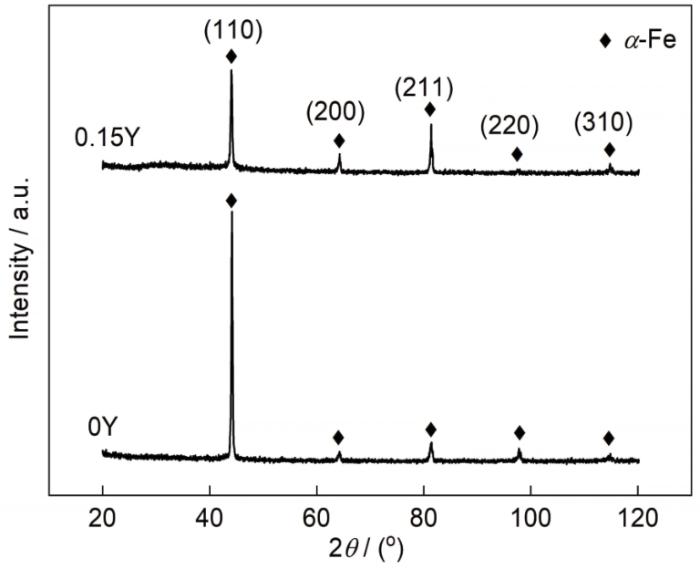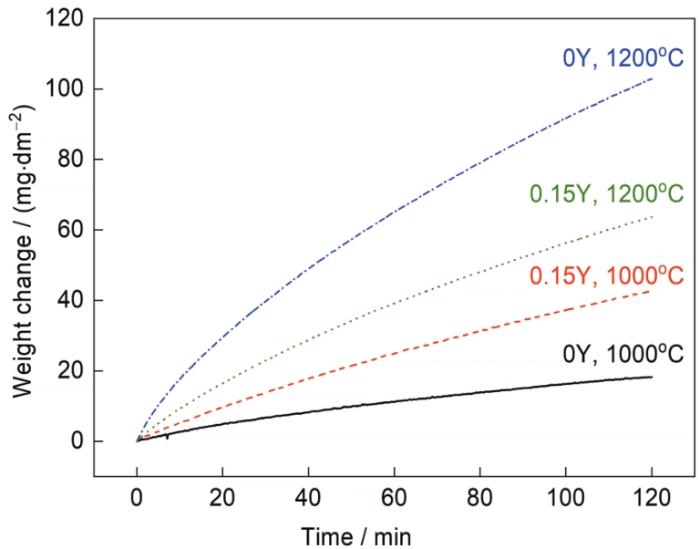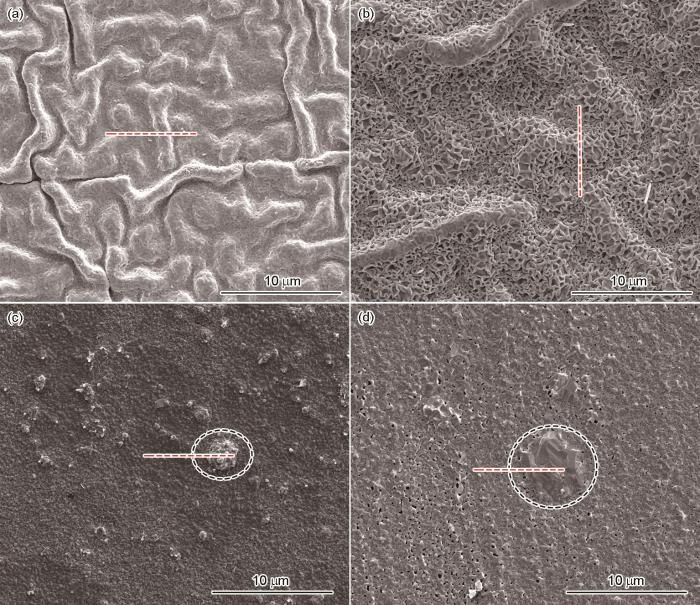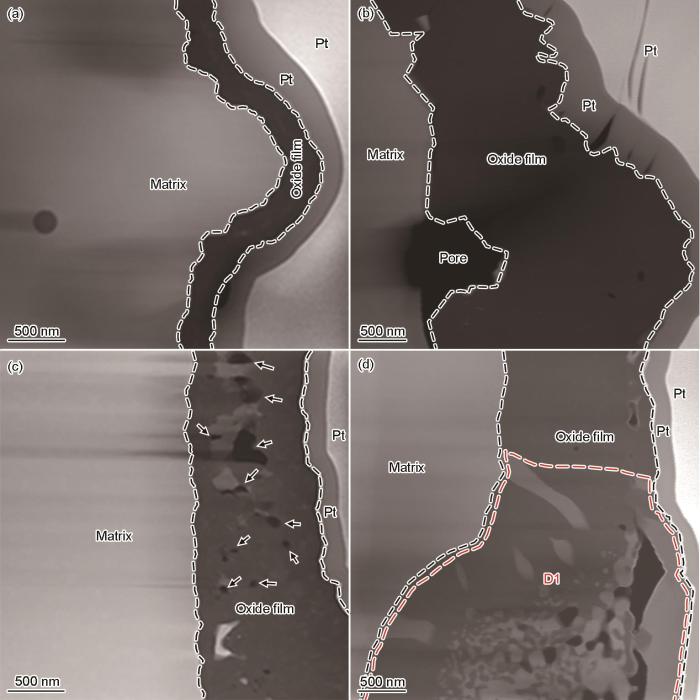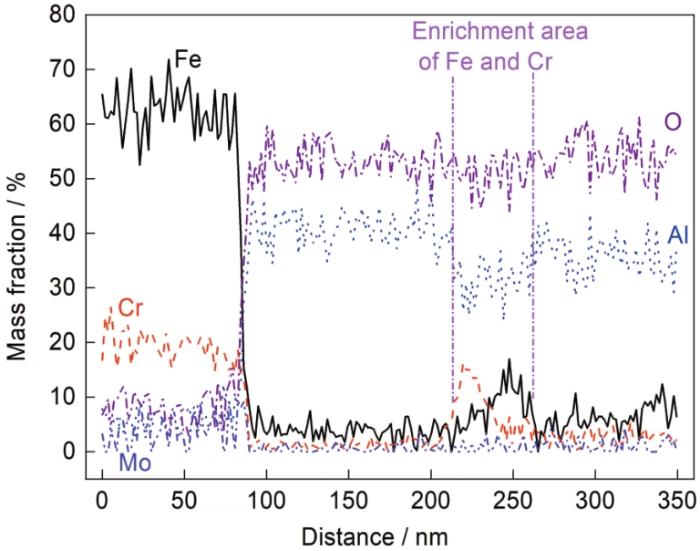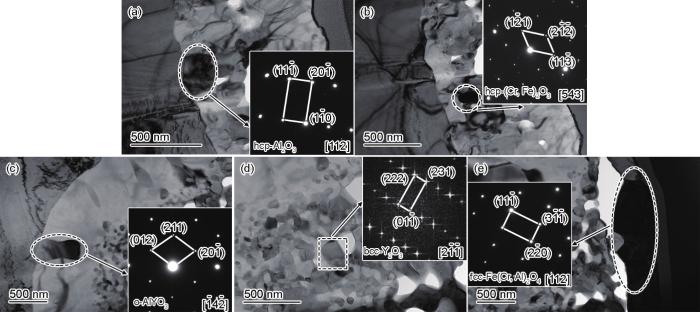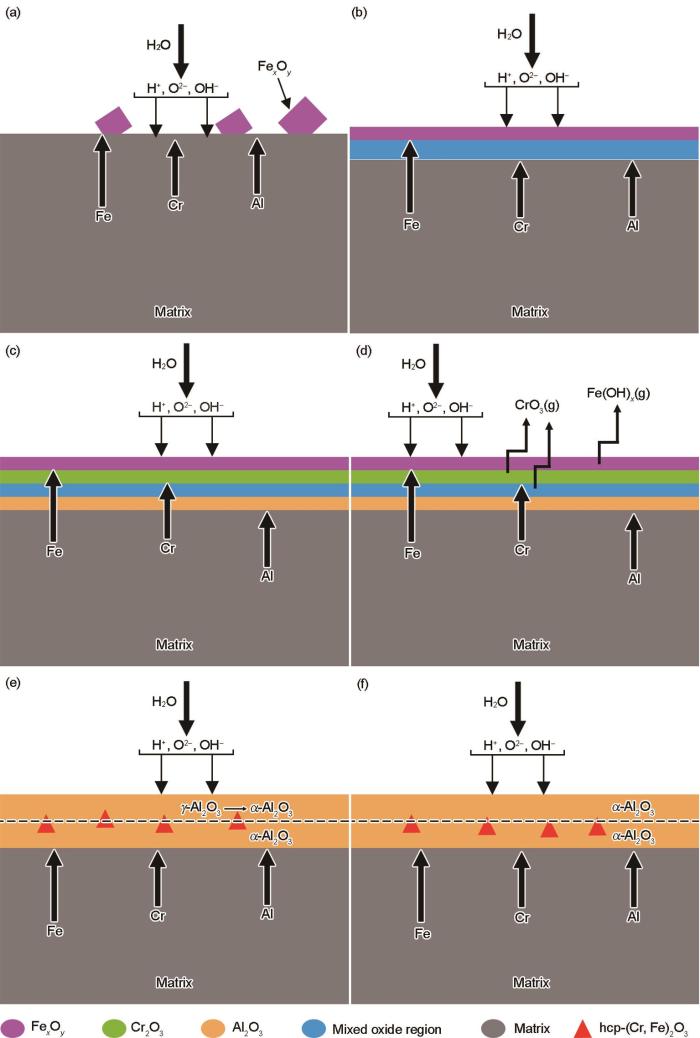Accident tolerant fuels for LWRs: A perspective
1
2014
... 失水事故(LOCA)工况下,锆合金在较高温度下会发生失稳氧化,导致燃料元件结构完整性遭到破坏[1],造成严重的核安全事故,因此事故容错燃料(accident-tolerant fuel,ATF)被用来提高核反应堆的固有安全性.FeCrAl合金由于具有适中的热中子吸收截面、与UO2相容性好、良好的导热性能和抗高温氧化性能等优点,被认为是有前景的ATF包壳候选材料之一[2~7].FeCrAl合金抗高温氧化性能的好坏直接影响到其抵抗严重事故的能力.因此,国内外开展了有关FeCrAl合金高温氧化行为的研究.研究[8~12]表明,FeCrAl合金在高温条件下具有较为优异的抗高温氧化性能与其表面形成保护性Al2O3膜有关.Liu等[13]研究发现,FeCrAl合金在900℃的干燥O2中氧化24 h时氧化膜外层由γ-Al2O3组成,内层由α-Al2O3组成,当氧化时间达到168 h时氧化膜外层大量的γ-Al2O3转变为α-Al2O3.Rebak等[9]对C26M (Fe12Cr6Al2Mo0.06Y,质量分数,%,下同)和APMT (Fe21Cr5Al3Mo)合金在800~1300℃空气中进行氧化研究时发现,2种合金表面均可形成连续的氧化膜,在较低温度下(800℃)氧化膜由富Al的内层氧化物和含Al、Cr和Fe的外层氧化物组成,在较高温度下(1200℃)氧化膜由单层Al2O3组成.Gupta等[12]研究发现,APMT合金在1050℃的空气中氧化8 h以及在1200℃的空气中氧化4 h时均会形成连续的Al2O3膜,且该氧化膜由外层较薄的等轴Al2O3和内层较厚的柱状Al2O3组成.目前对FeCrAl合金在高温空气或O2中的氧化行为研究较多,但作为水冷核反应堆燃料包壳候选材料,其在高温蒸汽中的氧化行为更为重要.Falaakh等[14]研究发现,FeCrAl合金在1200℃的蒸汽条件下氧化100 s、3 h和24 h时氧化膜均由连续的α-Al2O3组成,且Al2O3膜分为两层,内层Al2O3膜的形成是由O向内扩散控制,而外层则由Al向外扩散控制.Pan等[15]研究发现,Fe13.09Cr4.93Al2.07Mo1.04Nb合金在1000℃蒸汽中形成的氧化膜主要为FeO和α-Al2O3,而在1200℃蒸汽中形成的氧化膜主要为α-Al2O3.可见,FeCrAl合金在不同条件下的氧化行为存在差异,且非常复杂. ...
Current status of materials development of nuclear fuel cladding tubes for light water reactors
1
2017
... 失水事故(LOCA)工况下,锆合金在较高温度下会发生失稳氧化,导致燃料元件结构完整性遭到破坏[1],造成严重的核安全事故,因此事故容错燃料(accident-tolerant fuel,ATF)被用来提高核反应堆的固有安全性.FeCrAl合金由于具有适中的热中子吸收截面、与UO2相容性好、良好的导热性能和抗高温氧化性能等优点,被认为是有前景的ATF包壳候选材料之一[2~7].FeCrAl合金抗高温氧化性能的好坏直接影响到其抵抗严重事故的能力.因此,国内外开展了有关FeCrAl合金高温氧化行为的研究.研究[8~12]表明,FeCrAl合金在高温条件下具有较为优异的抗高温氧化性能与其表面形成保护性Al2O3膜有关.Liu等[13]研究发现,FeCrAl合金在900℃的干燥O2中氧化24 h时氧化膜外层由γ-Al2O3组成,内层由α-Al2O3组成,当氧化时间达到168 h时氧化膜外层大量的γ-Al2O3转变为α-Al2O3.Rebak等[9]对C26M (Fe12Cr6Al2Mo0.06Y,质量分数,%,下同)和APMT (Fe21Cr5Al3Mo)合金在800~1300℃空气中进行氧化研究时发现,2种合金表面均可形成连续的氧化膜,在较低温度下(800℃)氧化膜由富Al的内层氧化物和含Al、Cr和Fe的外层氧化物组成,在较高温度下(1200℃)氧化膜由单层Al2O3组成.Gupta等[12]研究发现,APMT合金在1050℃的空气中氧化8 h以及在1200℃的空气中氧化4 h时均会形成连续的Al2O3膜,且该氧化膜由外层较薄的等轴Al2O3和内层较厚的柱状Al2O3组成.目前对FeCrAl合金在高温空气或O2中的氧化行为研究较多,但作为水冷核反应堆燃料包壳候选材料,其在高温蒸汽中的氧化行为更为重要.Falaakh等[14]研究发现,FeCrAl合金在1200℃的蒸汽条件下氧化100 s、3 h和24 h时氧化膜均由连续的α-Al2O3组成,且Al2O3膜分为两层,内层Al2O3膜的形成是由O向内扩散控制,而外层则由Al向外扩散控制.Pan等[15]研究发现,Fe13.09Cr4.93Al2.07Mo1.04Nb合金在1000℃蒸汽中形成的氧化膜主要为FeO和α-Al2O3,而在1200℃蒸汽中形成的氧化膜主要为α-Al2O3.可见,FeCrAl合金在不同条件下的氧化行为存在差异,且非常复杂. ...
Accident tolerant FeCrAl fuel cladding: Current status towards commercialization
0
2017
Development and property evaluation of nuclear grade wrought FeCrAl fuel cladding for light water reactors
0
2015
Deformation behavior of laser welds in high temperature oxidation resistant Fe-Cr-Al alloys for fuel cladding applications
0
2014
Effect of H2O and CO2 on the oxidation behavior and durability at high temperature of ODS-FeCrAl
0
2013
Advanced oxidation-resistant iron-based alloys for LWR fuel cladding
1
2014
... 失水事故(LOCA)工况下,锆合金在较高温度下会发生失稳氧化,导致燃料元件结构完整性遭到破坏[1],造成严重的核安全事故,因此事故容错燃料(accident-tolerant fuel,ATF)被用来提高核反应堆的固有安全性.FeCrAl合金由于具有适中的热中子吸收截面、与UO2相容性好、良好的导热性能和抗高温氧化性能等优点,被认为是有前景的ATF包壳候选材料之一[2~7].FeCrAl合金抗高温氧化性能的好坏直接影响到其抵抗严重事故的能力.因此,国内外开展了有关FeCrAl合金高温氧化行为的研究.研究[8~12]表明,FeCrAl合金在高温条件下具有较为优异的抗高温氧化性能与其表面形成保护性Al2O3膜有关.Liu等[13]研究发现,FeCrAl合金在900℃的干燥O2中氧化24 h时氧化膜外层由γ-Al2O3组成,内层由α-Al2O3组成,当氧化时间达到168 h时氧化膜外层大量的γ-Al2O3转变为α-Al2O3.Rebak等[9]对C26M (Fe12Cr6Al2Mo0.06Y,质量分数,%,下同)和APMT (Fe21Cr5Al3Mo)合金在800~1300℃空气中进行氧化研究时发现,2种合金表面均可形成连续的氧化膜,在较低温度下(800℃)氧化膜由富Al的内层氧化物和含Al、Cr和Fe的外层氧化物组成,在较高温度下(1200℃)氧化膜由单层Al2O3组成.Gupta等[12]研究发现,APMT合金在1050℃的空气中氧化8 h以及在1200℃的空气中氧化4 h时均会形成连续的Al2O3膜,且该氧化膜由外层较薄的等轴Al2O3和内层较厚的柱状Al2O3组成.目前对FeCrAl合金在高温空气或O2中的氧化行为研究较多,但作为水冷核反应堆燃料包壳候选材料,其在高温蒸汽中的氧化行为更为重要.Falaakh等[14]研究发现,FeCrAl合金在1200℃的蒸汽条件下氧化100 s、3 h和24 h时氧化膜均由连续的α-Al2O3组成,且Al2O3膜分为两层,内层Al2O3膜的形成是由O向内扩散控制,而外层则由Al向外扩散控制.Pan等[15]研究发现,Fe13.09Cr4.93Al2.07Mo1.04Nb合金在1000℃蒸汽中形成的氧化膜主要为FeO和α-Al2O3,而在1200℃蒸汽中形成的氧化膜主要为α-Al2O3.可见,FeCrAl合金在不同条件下的氧化行为存在差异,且非常复杂. ...
Versatile oxide films protect FeCrAl alloys under normal operation and accident conditions in light water power reactors
1
2018
... 失水事故(LOCA)工况下,锆合金在较高温度下会发生失稳氧化,导致燃料元件结构完整性遭到破坏[1],造成严重的核安全事故,因此事故容错燃料(accident-tolerant fuel,ATF)被用来提高核反应堆的固有安全性.FeCrAl合金由于具有适中的热中子吸收截面、与UO2相容性好、良好的导热性能和抗高温氧化性能等优点,被认为是有前景的ATF包壳候选材料之一[2~7].FeCrAl合金抗高温氧化性能的好坏直接影响到其抵抗严重事故的能力.因此,国内外开展了有关FeCrAl合金高温氧化行为的研究.研究[8~12]表明,FeCrAl合金在高温条件下具有较为优异的抗高温氧化性能与其表面形成保护性Al2O3膜有关.Liu等[13]研究发现,FeCrAl合金在900℃的干燥O2中氧化24 h时氧化膜外层由γ-Al2O3组成,内层由α-Al2O3组成,当氧化时间达到168 h时氧化膜外层大量的γ-Al2O3转变为α-Al2O3.Rebak等[9]对C26M (Fe12Cr6Al2Mo0.06Y,质量分数,%,下同)和APMT (Fe21Cr5Al3Mo)合金在800~1300℃空气中进行氧化研究时发现,2种合金表面均可形成连续的氧化膜,在较低温度下(800℃)氧化膜由富Al的内层氧化物和含Al、Cr和Fe的外层氧化物组成,在较高温度下(1200℃)氧化膜由单层Al2O3组成.Gupta等[12]研究发现,APMT合金在1050℃的空气中氧化8 h以及在1200℃的空气中氧化4 h时均会形成连续的Al2O3膜,且该氧化膜由外层较薄的等轴Al2O3和内层较厚的柱状Al2O3组成.目前对FeCrAl合金在高温空气或O2中的氧化行为研究较多,但作为水冷核反应堆燃料包壳候选材料,其在高温蒸汽中的氧化行为更为重要.Falaakh等[14]研究发现,FeCrAl合金在1200℃的蒸汽条件下氧化100 s、3 h和24 h时氧化膜均由连续的α-Al2O3组成,且Al2O3膜分为两层,内层Al2O3膜的形成是由O向内扩散控制,而外层则由Al向外扩散控制.Pan等[15]研究发现,Fe13.09Cr4.93Al2.07Mo1.04Nb合金在1000℃蒸汽中形成的氧化膜主要为FeO和α-Al2O3,而在1200℃蒸汽中形成的氧化膜主要为α-Al2O3.可见,FeCrAl合金在不同条件下的氧化行为存在差异,且非常复杂. ...
Oxidation characteristics of two FeCrAl alloys in air and steam from 800oC to 1300oC
1
2018
... 失水事故(LOCA)工况下,锆合金在较高温度下会发生失稳氧化,导致燃料元件结构完整性遭到破坏[1],造成严重的核安全事故,因此事故容错燃料(accident-tolerant fuel,ATF)被用来提高核反应堆的固有安全性.FeCrAl合金由于具有适中的热中子吸收截面、与UO2相容性好、良好的导热性能和抗高温氧化性能等优点,被认为是有前景的ATF包壳候选材料之一[2~7].FeCrAl合金抗高温氧化性能的好坏直接影响到其抵抗严重事故的能力.因此,国内外开展了有关FeCrAl合金高温氧化行为的研究.研究[8~12]表明,FeCrAl合金在高温条件下具有较为优异的抗高温氧化性能与其表面形成保护性Al2O3膜有关.Liu等[13]研究发现,FeCrAl合金在900℃的干燥O2中氧化24 h时氧化膜外层由γ-Al2O3组成,内层由α-Al2O3组成,当氧化时间达到168 h时氧化膜外层大量的γ-Al2O3转变为α-Al2O3.Rebak等[9]对C26M (Fe12Cr6Al2Mo0.06Y,质量分数,%,下同)和APMT (Fe21Cr5Al3Mo)合金在800~1300℃空气中进行氧化研究时发现,2种合金表面均可形成连续的氧化膜,在较低温度下(800℃)氧化膜由富Al的内层氧化物和含Al、Cr和Fe的外层氧化物组成,在较高温度下(1200℃)氧化膜由单层Al2O3组成.Gupta等[12]研究发现,APMT合金在1050℃的空气中氧化8 h以及在1200℃的空气中氧化4 h时均会形成连续的Al2O3膜,且该氧化膜由外层较薄的等轴Al2O3和内层较厚的柱状Al2O3组成.目前对FeCrAl合金在高温空气或O2中的氧化行为研究较多,但作为水冷核反应堆燃料包壳候选材料,其在高温蒸汽中的氧化行为更为重要.Falaakh等[14]研究发现,FeCrAl合金在1200℃的蒸汽条件下氧化100 s、3 h和24 h时氧化膜均由连续的α-Al2O3组成,且Al2O3膜分为两层,内层Al2O3膜的形成是由O向内扩散控制,而外层则由Al向外扩散控制.Pan等[15]研究发现,Fe13.09Cr4.93Al2.07Mo1.04Nb合金在1000℃蒸汽中形成的氧化膜主要为FeO和α-Al2O3,而在1200℃蒸汽中形成的氧化膜主要为α-Al2O3.可见,FeCrAl合金在不同条件下的氧化行为存在差异,且非常复杂. ...
Studies on high-temperature oxidation and its influence mechanism of Fe-Cr-Al alloy
1
2013
... 根据上述反应式,FeCrAl合金在高温蒸汽中的氧化过程示意图如图8所示.初始升温阶段,水蒸气会分解成OH-、O2-和H+ [26],由于FeCrAl合金直接与水蒸气接触,Fe、Cr、Al均发生氧化,在合金外表面形成一层氧化膜[25].随着升温阶段的不断进行,氧化性离子向内扩散,Fe2+/3+、Cr3+和Al3+向外扩散,由于Fe2+/3+的扩散速率远高于Cr3+和Al3+ [27],所以Fe的氧化物(反应(2))会优先在合金表面形成(图8a).接着,Cr3+和Al3+也会分别与氧化性离子反应生成Cr2O3和Al2O3 (反应(3)和(4)),由于Cr和Al的扩散速率相近且Cr2O3和Al2O3可以互相固溶[15,28],所以此时会形成Cr和Al的混合氧化物区(图8b).随着氧化时间的延长,Cr和Al的混合氧化物区不断变厚,导致O/M界面处的氧分压降低,而Fe、Cr、Al发生氧化时的氧分压为Al < Cr < Fe[10],因此Cr3+会继续向外扩散至Cr和Al的混合氧化物区/Fe氧化物界面处并氧化形成Cr氧化物膜,而Al3+则可以在O/M界面处发生氧化形成Al氧化物膜.随着氧化的进行,各层氧化膜不断生长变厚(图8c).研究[12,29,30]表明,当氧化温度升高至1000℃时α-Cr2O3会氧化生成CrO3并挥发,即发生反应(6).此外,高温条件下Fe的氧化物还会与高温蒸汽反应生成挥发性氢氧化物(反应(5)).因此氧化温度不断升高时,FeCrAl合金表面的Cr和Fe的氧化物会进一步反应生成挥发性物质(图8d). ...
Fe-Cr-Al合金高温氧化及影响机理研究
1
2013
... 根据上述反应式,FeCrAl合金在高温蒸汽中的氧化过程示意图如图8所示.初始升温阶段,水蒸气会分解成OH-、O2-和H+ [26],由于FeCrAl合金直接与水蒸气接触,Fe、Cr、Al均发生氧化,在合金外表面形成一层氧化膜[25].随着升温阶段的不断进行,氧化性离子向内扩散,Fe2+/3+、Cr3+和Al3+向外扩散,由于Fe2+/3+的扩散速率远高于Cr3+和Al3+ [27],所以Fe的氧化物(反应(2))会优先在合金表面形成(图8a).接着,Cr3+和Al3+也会分别与氧化性离子反应生成Cr2O3和Al2O3 (反应(3)和(4)),由于Cr和Al的扩散速率相近且Cr2O3和Al2O3可以互相固溶[15,28],所以此时会形成Cr和Al的混合氧化物区(图8b).随着氧化时间的延长,Cr和Al的混合氧化物区不断变厚,导致O/M界面处的氧分压降低,而Fe、Cr、Al发生氧化时的氧分压为Al < Cr < Fe[10],因此Cr3+会继续向外扩散至Cr和Al的混合氧化物区/Fe氧化物界面处并氧化形成Cr氧化物膜,而Al3+则可以在O/M界面处发生氧化形成Al氧化物膜.随着氧化的进行,各层氧化膜不断生长变厚(图8c).研究[12,29,30]表明,当氧化温度升高至1000℃时α-Cr2O3会氧化生成CrO3并挥发,即发生反应(6).此外,高温条件下Fe的氧化物还会与高温蒸汽反应生成挥发性氢氧化物(反应(5)).因此氧化温度不断升高时,FeCrAl合金表面的Cr和Fe的氧化物会进一步反应生成挥发性物质(图8d). ...
Oxidation of FeCrAl alloy: Influence of temperature and atmosphere on scale growth rate and mechanism
0
2001
Utilizing FeCrAl oxidation resistance properties in water, air and steam for accident tolerant fuel cladding
4
2018
... 失水事故(LOCA)工况下,锆合金在较高温度下会发生失稳氧化,导致燃料元件结构完整性遭到破坏[1],造成严重的核安全事故,因此事故容错燃料(accident-tolerant fuel,ATF)被用来提高核反应堆的固有安全性.FeCrAl合金由于具有适中的热中子吸收截面、与UO2相容性好、良好的导热性能和抗高温氧化性能等优点,被认为是有前景的ATF包壳候选材料之一[2~7].FeCrAl合金抗高温氧化性能的好坏直接影响到其抵抗严重事故的能力.因此,国内外开展了有关FeCrAl合金高温氧化行为的研究.研究[8~12]表明,FeCrAl合金在高温条件下具有较为优异的抗高温氧化性能与其表面形成保护性Al2O3膜有关.Liu等[13]研究发现,FeCrAl合金在900℃的干燥O2中氧化24 h时氧化膜外层由γ-Al2O3组成,内层由α-Al2O3组成,当氧化时间达到168 h时氧化膜外层大量的γ-Al2O3转变为α-Al2O3.Rebak等[9]对C26M (Fe12Cr6Al2Mo0.06Y,质量分数,%,下同)和APMT (Fe21Cr5Al3Mo)合金在800~1300℃空气中进行氧化研究时发现,2种合金表面均可形成连续的氧化膜,在较低温度下(800℃)氧化膜由富Al的内层氧化物和含Al、Cr和Fe的外层氧化物组成,在较高温度下(1200℃)氧化膜由单层Al2O3组成.Gupta等[12]研究发现,APMT合金在1050℃的空气中氧化8 h以及在1200℃的空气中氧化4 h时均会形成连续的Al2O3膜,且该氧化膜由外层较薄的等轴Al2O3和内层较厚的柱状Al2O3组成.目前对FeCrAl合金在高温空气或O2中的氧化行为研究较多,但作为水冷核反应堆燃料包壳候选材料,其在高温蒸汽中的氧化行为更为重要.Falaakh等[14]研究发现,FeCrAl合金在1200℃的蒸汽条件下氧化100 s、3 h和24 h时氧化膜均由连续的α-Al2O3组成,且Al2O3膜分为两层,内层Al2O3膜的形成是由O向内扩散控制,而外层则由Al向外扩散控制.Pan等[15]研究发现,Fe13.09Cr4.93Al2.07Mo1.04Nb合金在1000℃蒸汽中形成的氧化膜主要为FeO和α-Al2O3,而在1200℃蒸汽中形成的氧化膜主要为α-Al2O3.可见,FeCrAl合金在不同条件下的氧化行为存在差异,且非常复杂. ...
... [12]研究发现,APMT合金在1050℃的空气中氧化8 h以及在1200℃的空气中氧化4 h时均会形成连续的Al2O3膜,且该氧化膜由外层较薄的等轴Al2O3和内层较厚的柱状Al2O3组成.目前对FeCrAl合金在高温空气或O2中的氧化行为研究较多,但作为水冷核反应堆燃料包壳候选材料,其在高温蒸汽中的氧化行为更为重要.Falaakh等[14]研究发现,FeCrAl合金在1200℃的蒸汽条件下氧化100 s、3 h和24 h时氧化膜均由连续的α-Al2O3组成,且Al2O3膜分为两层,内层Al2O3膜的形成是由O向内扩散控制,而外层则由Al向外扩散控制.Pan等[15]研究发现,Fe13.09Cr4.93Al2.07Mo1.04Nb合金在1000℃蒸汽中形成的氧化膜主要为FeO和α-Al2O3,而在1200℃蒸汽中形成的氧化膜主要为α-Al2O3.可见,FeCrAl合金在不同条件下的氧化行为存在差异,且非常复杂. ...
... 根据上述反应式,FeCrAl合金在高温蒸汽中的氧化过程示意图如图8所示.初始升温阶段,水蒸气会分解成OH-、O2-和H+ [26],由于FeCrAl合金直接与水蒸气接触,Fe、Cr、Al均发生氧化,在合金外表面形成一层氧化膜[25].随着升温阶段的不断进行,氧化性离子向内扩散,Fe2+/3+、Cr3+和Al3+向外扩散,由于Fe2+/3+的扩散速率远高于Cr3+和Al3+ [27],所以Fe的氧化物(反应(2))会优先在合金表面形成(图8a).接着,Cr3+和Al3+也会分别与氧化性离子反应生成Cr2O3和Al2O3 (反应(3)和(4)),由于Cr和Al的扩散速率相近且Cr2O3和Al2O3可以互相固溶[15,28],所以此时会形成Cr和Al的混合氧化物区(图8b).随着氧化时间的延长,Cr和Al的混合氧化物区不断变厚,导致O/M界面处的氧分压降低,而Fe、Cr、Al发生氧化时的氧分压为Al < Cr < Fe[10],因此Cr3+会继续向外扩散至Cr和Al的混合氧化物区/Fe氧化物界面处并氧化形成Cr氧化物膜,而Al3+则可以在O/M界面处发生氧化形成Al氧化物膜.随着氧化的进行,各层氧化膜不断生长变厚(图8c).研究[12,29,30]表明,当氧化温度升高至1000℃时α-Cr2O3会氧化生成CrO3并挥发,即发生反应(6).此外,高温条件下Fe的氧化物还会与高温蒸汽反应生成挥发性氢氧化物(反应(5)).因此氧化温度不断升高时,FeCrAl合金表面的Cr和Fe的氧化物会进一步反应生成挥发性物质(图8d). ...
... 对于Fe、Cr富集区的形成原因,有的观点认为Fe、Cr富集区是合金的原始外表面[12,22],也有观点认为Fe、Cr富集区是样品在升温过程中形成的Fe、Cr氧化物的残余物[29].本工作认为在氧化初期形成的Fe和Cr的氧化物在高温氧化过程中会进一步反应形成挥发性物质,但仍会有部分Fe和Cr的氧化物未发生进一步反应,其会以hcp-(Cr, Fe)2O3的形式残留在Al2O3膜中;由于更高的温度会促进Fe和Cr的氧化物反应生成挥发性物质,所以在1000℃条件下形成的氧化膜中的Fe、Cr富集区比在1200℃下明显. ...
TEM investigation of the microstructure of the scale formed on a FeCrAlRE alloy at 900oC: The effect of Y-rich RE particles
3
2010
... 失水事故(LOCA)工况下,锆合金在较高温度下会发生失稳氧化,导致燃料元件结构完整性遭到破坏[1],造成严重的核安全事故,因此事故容错燃料(accident-tolerant fuel,ATF)被用来提高核反应堆的固有安全性.FeCrAl合金由于具有适中的热中子吸收截面、与UO2相容性好、良好的导热性能和抗高温氧化性能等优点,被认为是有前景的ATF包壳候选材料之一[2~7].FeCrAl合金抗高温氧化性能的好坏直接影响到其抵抗严重事故的能力.因此,国内外开展了有关FeCrAl合金高温氧化行为的研究.研究[8~12]表明,FeCrAl合金在高温条件下具有较为优异的抗高温氧化性能与其表面形成保护性Al2O3膜有关.Liu等[13]研究发现,FeCrAl合金在900℃的干燥O2中氧化24 h时氧化膜外层由γ-Al2O3组成,内层由α-Al2O3组成,当氧化时间达到168 h时氧化膜外层大量的γ-Al2O3转变为α-Al2O3.Rebak等[9]对C26M (Fe12Cr6Al2Mo0.06Y,质量分数,%,下同)和APMT (Fe21Cr5Al3Mo)合金在800~1300℃空气中进行氧化研究时发现,2种合金表面均可形成连续的氧化膜,在较低温度下(800℃)氧化膜由富Al的内层氧化物和含Al、Cr和Fe的外层氧化物组成,在较高温度下(1200℃)氧化膜由单层Al2O3组成.Gupta等[12]研究发现,APMT合金在1050℃的空气中氧化8 h以及在1200℃的空气中氧化4 h时均会形成连续的Al2O3膜,且该氧化膜由外层较薄的等轴Al2O3和内层较厚的柱状Al2O3组成.目前对FeCrAl合金在高温空气或O2中的氧化行为研究较多,但作为水冷核反应堆燃料包壳候选材料,其在高温蒸汽中的氧化行为更为重要.Falaakh等[14]研究发现,FeCrAl合金在1200℃的蒸汽条件下氧化100 s、3 h和24 h时氧化膜均由连续的α-Al2O3组成,且Al2O3膜分为两层,内层Al2O3膜的形成是由O向内扩散控制,而外层则由Al向外扩散控制.Pan等[15]研究发现,Fe13.09Cr4.93Al2.07Mo1.04Nb合金在1000℃蒸汽中形成的氧化膜主要为FeO和α-Al2O3,而在1200℃蒸汽中形成的氧化膜主要为α-Al2O3.可见,FeCrAl合金在不同条件下的氧化行为存在差异,且非常复杂. ...
... 合金化会改变FeCrAl合金的显微组织,进而影响合金的性能.Mennicke等[16]研究发现,在1200℃下添加Y可以抑制FeCrAl合金中Al的向外扩散.Cueff等[17,18]的研究表明,Y可以通过抑制过渡型Al2O3的形成并促进保护性α-Al2O3膜的形成来降低FeCrAl合金的氧化速率.Issartel等[19]研究发现,Y的添加也降低了FeCrAl合金在1100℃空气中的氧化速率.Liu等[13]研究发现,FeCrAl合金中富Y氧化物颗粒周围会存在较厚的Al2O3膜.可见,Y的添加改变了FeCrAl合金在高温条件下的氧化膜特性,从而影响其抗高温氧化性能,但Y对FeCrAl合金在高温蒸汽条件下的氧化膜显微组织演化的影响还缺乏系统研究. ...
... Y在FeCrAl合金中的溶解度很低[41],根据Fe-Y二元相图可知,即使在1200℃的高温环境中进行氧化实验,合金中仍存在含Y第二相[42],因此添加0.15Y的FeCrAl合金中会析出含Y第二相,含Y第二相的形成会导致第二相或其周围存在成分梯度,从而导致其在氧化环境中会发生快速氧化,形成较厚的氧化物[13];此外,添加Y可以抑制阳离子向外扩散,降低了氧化膜向外生长的速率,因此0.15Y合金在1200℃高温蒸汽条件下恒温2 h后氧化膜中的含Y第二相在发生氧化时会朝向基体一侧生长(图4和5).0.15Y合金在1200℃高温蒸汽条件下恒温2 h后氧化膜中的富Y氧化物区域存在bcc-Y2O3和o-AlYO3 (图7),这是由于YAlO3 (YAP)一般是在1100~1250℃范围内生成,为正交结构[43,44],Y2O3与Al2O3反应会形成YAP[45]. ...
Microstructure of aluminium oxide formed on ferritic FeCrAl alloy after high-temperature steam oxidation
3
2020
... 失水事故(LOCA)工况下,锆合金在较高温度下会发生失稳氧化,导致燃料元件结构完整性遭到破坏[1],造成严重的核安全事故,因此事故容错燃料(accident-tolerant fuel,ATF)被用来提高核反应堆的固有安全性.FeCrAl合金由于具有适中的热中子吸收截面、与UO2相容性好、良好的导热性能和抗高温氧化性能等优点,被认为是有前景的ATF包壳候选材料之一[2~7].FeCrAl合金抗高温氧化性能的好坏直接影响到其抵抗严重事故的能力.因此,国内外开展了有关FeCrAl合金高温氧化行为的研究.研究[8~12]表明,FeCrAl合金在高温条件下具有较为优异的抗高温氧化性能与其表面形成保护性Al2O3膜有关.Liu等[13]研究发现,FeCrAl合金在900℃的干燥O2中氧化24 h时氧化膜外层由γ-Al2O3组成,内层由α-Al2O3组成,当氧化时间达到168 h时氧化膜外层大量的γ-Al2O3转变为α-Al2O3.Rebak等[9]对C26M (Fe12Cr6Al2Mo0.06Y,质量分数,%,下同)和APMT (Fe21Cr5Al3Mo)合金在800~1300℃空气中进行氧化研究时发现,2种合金表面均可形成连续的氧化膜,在较低温度下(800℃)氧化膜由富Al的内层氧化物和含Al、Cr和Fe的外层氧化物组成,在较高温度下(1200℃)氧化膜由单层Al2O3组成.Gupta等[12]研究发现,APMT合金在1050℃的空气中氧化8 h以及在1200℃的空气中氧化4 h时均会形成连续的Al2O3膜,且该氧化膜由外层较薄的等轴Al2O3和内层较厚的柱状Al2O3组成.目前对FeCrAl合金在高温空气或O2中的氧化行为研究较多,但作为水冷核反应堆燃料包壳候选材料,其在高温蒸汽中的氧化行为更为重要.Falaakh等[14]研究发现,FeCrAl合金在1200℃的蒸汽条件下氧化100 s、3 h和24 h时氧化膜均由连续的α-Al2O3组成,且Al2O3膜分为两层,内层Al2O3膜的形成是由O向内扩散控制,而外层则由Al向外扩散控制.Pan等[15]研究发现,Fe13.09Cr4.93Al2.07Mo1.04Nb合金在1000℃蒸汽中形成的氧化膜主要为FeO和α-Al2O3,而在1200℃蒸汽中形成的氧化膜主要为α-Al2O3.可见,FeCrAl合金在不同条件下的氧化行为存在差异,且非常复杂. ...
... 研究[14,22]表明,FeCrAl合金在高温条件下形成的Al2O3膜主要包括向内生长的内层α-Al2O3和向外生长的外层γ-Al2O3 (过渡型Al2O3,即亚稳态Al2O3).1000℃是亚稳态Al2O3和α-Al2O3两相区,而1200℃是α-Al2O3单相区[31].亚稳态Al2O3通常出现在较低的氧化温度下(低于900℃),其是热力学不稳定的,在较高温度下会转变为α-Al2O3[23,32].亚稳态Al2O3向α-Al2O3的转变与温度有关,在低于1000℃时的转变相对缓慢[33].在氧化温度升至1000℃时,0Y和0.15Y合金表面的Al2O3膜包括内层α-Al2O3和外层亚稳态Al2O3.随着恒温氧化时间的延长以及氧化温度的升高,α-Al2O3膜不断变厚,这会进一步抑制亚稳态Al2O3的形成,同时亚稳态Al2O3会逐渐转变为α-Al2O3 (图8e).需要指出的是,图8d中的氧化阶段在图8e所示氧化阶段中仍然发生.当恒温2 h后,合金氧化膜均为α-Al2O3膜,外层亚稳态Al2O3已经完全转变为α-Al2O3;当氧化温度升至1200℃时,0Y和0.15Y合金表面的Al2O3膜均为α-Al2O3,所以在1200℃恒温氧化2 h的过程中合金表面的α-Al2O3膜会不断生长变厚(图8f). ...
... 添加Y可以改变氧化膜的生长机制,抑制阳离子向外扩散,导致氧化膜的生长依赖于O的向内扩散,抑制了氧化膜的横向生长,从而避免了氧化膜脊状形貌的形成,同时还降低了氧化膜中的应力[16,19,39,40].此外,FeCrAl合金在高温条件下形成的Al2O3膜由O向内扩散控制的内层α-Al2O3和Al向外扩散控制的外层γ-Al2O3组成;随着氧化的进行,外层γ-Al2O3逐渐转变为α-Al2O3.亚稳态Al2O3相的形成及其向稳定α-Al2O3相的转变是导致氧化膜外表面(即氧化膜/气相界面)呈现粗糙不平的脊状形貌的原因[14].由于Y的添加会抑制Al2O3膜的向外生长[19,36,37],即Y的添加会抑制亚稳态Al2O3相的形成.因此,不论是在1000℃还是1200℃下的氧化过程中,含Y合金形成的亚稳态Al2O3的总含量均低于不含Y合金,导致亚稳态Al2O3向α-Al2O3的转变量变少,所以不含Y合金表面更易形成脊状形貌.本工作中0Y合金氧化膜外表面呈脊状形貌,而0.15Y合金氧化膜表面未出现脊状形貌的现象也可以验证上述理论. ...
In steam short-time oxidation kinetics of FeCrAl alloys
2
2018
... 失水事故(LOCA)工况下,锆合金在较高温度下会发生失稳氧化,导致燃料元件结构完整性遭到破坏[1],造成严重的核安全事故,因此事故容错燃料(accident-tolerant fuel,ATF)被用来提高核反应堆的固有安全性.FeCrAl合金由于具有适中的热中子吸收截面、与UO2相容性好、良好的导热性能和抗高温氧化性能等优点,被认为是有前景的ATF包壳候选材料之一[2~7].FeCrAl合金抗高温氧化性能的好坏直接影响到其抵抗严重事故的能力.因此,国内外开展了有关FeCrAl合金高温氧化行为的研究.研究[8~12]表明,FeCrAl合金在高温条件下具有较为优异的抗高温氧化性能与其表面形成保护性Al2O3膜有关.Liu等[13]研究发现,FeCrAl合金在900℃的干燥O2中氧化24 h时氧化膜外层由γ-Al2O3组成,内层由α-Al2O3组成,当氧化时间达到168 h时氧化膜外层大量的γ-Al2O3转变为α-Al2O3.Rebak等[9]对C26M (Fe12Cr6Al2Mo0.06Y,质量分数,%,下同)和APMT (Fe21Cr5Al3Mo)合金在800~1300℃空气中进行氧化研究时发现,2种合金表面均可形成连续的氧化膜,在较低温度下(800℃)氧化膜由富Al的内层氧化物和含Al、Cr和Fe的外层氧化物组成,在较高温度下(1200℃)氧化膜由单层Al2O3组成.Gupta等[12]研究发现,APMT合金在1050℃的空气中氧化8 h以及在1200℃的空气中氧化4 h时均会形成连续的Al2O3膜,且该氧化膜由外层较薄的等轴Al2O3和内层较厚的柱状Al2O3组成.目前对FeCrAl合金在高温空气或O2中的氧化行为研究较多,但作为水冷核反应堆燃料包壳候选材料,其在高温蒸汽中的氧化行为更为重要.Falaakh等[14]研究发现,FeCrAl合金在1200℃的蒸汽条件下氧化100 s、3 h和24 h时氧化膜均由连续的α-Al2O3组成,且Al2O3膜分为两层,内层Al2O3膜的形成是由O向内扩散控制,而外层则由Al向外扩散控制.Pan等[15]研究发现,Fe13.09Cr4.93Al2.07Mo1.04Nb合金在1000℃蒸汽中形成的氧化膜主要为FeO和α-Al2O3,而在1200℃蒸汽中形成的氧化膜主要为α-Al2O3.可见,FeCrAl合金在不同条件下的氧化行为存在差异,且非常复杂. ...
... 根据上述反应式,FeCrAl合金在高温蒸汽中的氧化过程示意图如图8所示.初始升温阶段,水蒸气会分解成OH-、O2-和H+ [26],由于FeCrAl合金直接与水蒸气接触,Fe、Cr、Al均发生氧化,在合金外表面形成一层氧化膜[25].随着升温阶段的不断进行,氧化性离子向内扩散,Fe2+/3+、Cr3+和Al3+向外扩散,由于Fe2+/3+的扩散速率远高于Cr3+和Al3+ [27],所以Fe的氧化物(反应(2))会优先在合金表面形成(图8a).接着,Cr3+和Al3+也会分别与氧化性离子反应生成Cr2O3和Al2O3 (反应(3)和(4)),由于Cr和Al的扩散速率相近且Cr2O3和Al2O3可以互相固溶[15,28],所以此时会形成Cr和Al的混合氧化物区(图8b).随着氧化时间的延长,Cr和Al的混合氧化物区不断变厚,导致O/M界面处的氧分压降低,而Fe、Cr、Al发生氧化时的氧分压为Al < Cr < Fe[10],因此Cr3+会继续向外扩散至Cr和Al的混合氧化物区/Fe氧化物界面处并氧化形成Cr氧化物膜,而Al3+则可以在O/M界面处发生氧化形成Al氧化物膜.随着氧化的进行,各层氧化膜不断生长变厚(图8c).研究[12,29,30]表明,当氧化温度升高至1000℃时α-Cr2O3会氧化生成CrO3并挥发,即发生反应(6).此外,高温条件下Fe的氧化物还会与高温蒸汽反应生成挥发性氢氧化物(反应(5)).因此氧化温度不断升高时,FeCrAl合金表面的Cr和Fe的氧化物会进一步反应生成挥发性物质(图8d). ...
The effect of yttrium on the growth process and microstructure of α-Al2O3 on FeCrAl
2
1998
... 合金化会改变FeCrAl合金的显微组织,进而影响合金的性能.Mennicke等[16]研究发现,在1200℃下添加Y可以抑制FeCrAl合金中Al的向外扩散.Cueff等[17,18]的研究表明,Y可以通过抑制过渡型Al2O3的形成并促进保护性α-Al2O3膜的形成来降低FeCrAl合金的氧化速率.Issartel等[19]研究发现,Y的添加也降低了FeCrAl合金在1100℃空气中的氧化速率.Liu等[13]研究发现,FeCrAl合金中富Y氧化物颗粒周围会存在较厚的Al2O3膜.可见,Y的添加改变了FeCrAl合金在高温条件下的氧化膜特性,从而影响其抗高温氧化性能,但Y对FeCrAl合金在高温蒸汽条件下的氧化膜显微组织演化的影响还缺乏系统研究. ...
... 添加Y可以改变氧化膜的生长机制,抑制阳离子向外扩散,导致氧化膜的生长依赖于O的向内扩散,抑制了氧化膜的横向生长,从而避免了氧化膜脊状形貌的形成,同时还降低了氧化膜中的应力[16,19,39,40].此外,FeCrAl合金在高温条件下形成的Al2O3膜由O向内扩散控制的内层α-Al2O3和Al向外扩散控制的外层γ-Al2O3组成;随着氧化的进行,外层γ-Al2O3逐渐转变为α-Al2O3.亚稳态Al2O3相的形成及其向稳定α-Al2O3相的转变是导致氧化膜外表面(即氧化膜/气相界面)呈现粗糙不平的脊状形貌的原因[14].由于Y的添加会抑制Al2O3膜的向外生长[19,36,37],即Y的添加会抑制亚稳态Al2O3相的形成.因此,不论是在1000℃还是1200℃下的氧化过程中,含Y合金形成的亚稳态Al2O3的总含量均低于不含Y合金,导致亚稳态Al2O3向α-Al2O3的转变量变少,所以不含Y合金表面更易形成脊状形貌.本工作中0Y合金氧化膜外表面呈脊状形貌,而0.15Y合金氧化膜表面未出现脊状形貌的现象也可以验证上述理论. ...
Oxidation behaviour of Kanthal A1 and Kanthal AF at 1173 K: Effect of yttrium alloying addition
1
2003
... 合金化会改变FeCrAl合金的显微组织,进而影响合金的性能.Mennicke等[16]研究发现,在1200℃下添加Y可以抑制FeCrAl合金中Al的向外扩散.Cueff等[17,18]的研究表明,Y可以通过抑制过渡型Al2O3的形成并促进保护性α-Al2O3膜的形成来降低FeCrAl合金的氧化速率.Issartel等[19]研究发现,Y的添加也降低了FeCrAl合金在1100℃空气中的氧化速率.Liu等[13]研究发现,FeCrAl合金中富Y氧化物颗粒周围会存在较厚的Al2O3膜.可见,Y的添加改变了FeCrAl合金在高温条件下的氧化膜特性,从而影响其抗高温氧化性能,但Y对FeCrAl合金在高温蒸汽条件下的氧化膜显微组织演化的影响还缺乏系统研究. ...
Oxidation of alumina formers at 1173 K: Effect of yttrium ion implantation and yttrium alloying addition
1
2003
... 合金化会改变FeCrAl合金的显微组织,进而影响合金的性能.Mennicke等[16]研究发现,在1200℃下添加Y可以抑制FeCrAl合金中Al的向外扩散.Cueff等[17,18]的研究表明,Y可以通过抑制过渡型Al2O3的形成并促进保护性α-Al2O3膜的形成来降低FeCrAl合金的氧化速率.Issartel等[19]研究发现,Y的添加也降低了FeCrAl合金在1100℃空气中的氧化速率.Liu等[13]研究发现,FeCrAl合金中富Y氧化物颗粒周围会存在较厚的Al2O3膜.可见,Y的添加改变了FeCrAl合金在高温条件下的氧化膜特性,从而影响其抗高温氧化性能,但Y对FeCrAl合金在高温蒸汽条件下的氧化膜显微组织演化的影响还缺乏系统研究. ...
Effect of yttrium as alloying element on a model alumina-forming alloy oxidation at 1100oC
5
2017
... 合金化会改变FeCrAl合金的显微组织,进而影响合金的性能.Mennicke等[16]研究发现,在1200℃下添加Y可以抑制FeCrAl合金中Al的向外扩散.Cueff等[17,18]的研究表明,Y可以通过抑制过渡型Al2O3的形成并促进保护性α-Al2O3膜的形成来降低FeCrAl合金的氧化速率.Issartel等[19]研究发现,Y的添加也降低了FeCrAl合金在1100℃空气中的氧化速率.Liu等[13]研究发现,FeCrAl合金中富Y氧化物颗粒周围会存在较厚的Al2O3膜.可见,Y的添加改变了FeCrAl合金在高温条件下的氧化膜特性,从而影响其抗高温氧化性能,但Y对FeCrAl合金在高温蒸汽条件下的氧化膜显微组织演化的影响还缺乏系统研究. ...
... 在1000和1200℃高温蒸汽条件下恒温2 h的过程中,FeCrAl合金的氧化动力学均遵循抛物线规律,且随温度的升高,氧化增重速率增加,这是由于温度的升高会加速金属离子和氧化性离子的扩散速率,从而提高氧化增重速率.1000℃是亚稳态Al2O3和α-Al2O3两相区,而1200℃是α-Al2O3单相区[31].Y的添加可以提高亚稳态Al2O3转变为α-Al2O3的相变温度[34],也就是说Y的添加可以延迟亚稳态Al2O3向α-Al2O3的转变[35].此外,Y的添加也会抑制Al2O3膜的向外生长,即Y的添加会抑制亚稳态Al2O3的形成[19,36,37].因此,在1000℃氧化过程中,与不含Y合金相比,含Y合金形成的亚稳态Al2O3的总含量较少,但含Y合金中亚稳态Al2O3转变为α-Al2O3的相变温度较高,导致含Y合金中亚稳态Al2O3转变为α-Al2O3的速率降低,由于温度对γ-Al2O3向α-Al2O3转变的影响程度可能大于Y对亚稳态Al2O3形成的抑制作用,所以在1000℃恒温氧化开始时,含Y合金中未转变为α-Al2O3的亚稳态Al2O3的含量可能高于0Y合金,因此在1000℃恒温2 h的氧化过程中含Y合金中可能存在较多的未转变为α-Al2O3的亚稳态Al2O3.由于亚稳态Al2O3的生长速率高于α-Al2O3[38],所以0.15Y合金在1000℃高温蒸汽条件下恒温2 h后的氧化增重高于0Y合金.当氧化温度升至1200℃时,0Y和0.15Y合金的氧化膜均为α-Al2O3,而Y的添加可以抑制Al在氧化膜中向外扩散的速率[19],进而降低了氧化膜的生长速率,所以0.15Y合金在1200℃高温蒸汽条件下恒温2 h后的氧化速率低于0Y合金. ...
... [19],进而降低了氧化膜的生长速率,所以0.15Y合金在1200℃高温蒸汽条件下恒温2 h后的氧化速率低于0Y合金. ...
... 添加Y可以改变氧化膜的生长机制,抑制阳离子向外扩散,导致氧化膜的生长依赖于O的向内扩散,抑制了氧化膜的横向生长,从而避免了氧化膜脊状形貌的形成,同时还降低了氧化膜中的应力[16,19,39,40].此外,FeCrAl合金在高温条件下形成的Al2O3膜由O向内扩散控制的内层α-Al2O3和Al向外扩散控制的外层γ-Al2O3组成;随着氧化的进行,外层γ-Al2O3逐渐转变为α-Al2O3.亚稳态Al2O3相的形成及其向稳定α-Al2O3相的转变是导致氧化膜外表面(即氧化膜/气相界面)呈现粗糙不平的脊状形貌的原因[14].由于Y的添加会抑制Al2O3膜的向外生长[19,36,37],即Y的添加会抑制亚稳态Al2O3相的形成.因此,不论是在1000℃还是1200℃下的氧化过程中,含Y合金形成的亚稳态Al2O3的总含量均低于不含Y合金,导致亚稳态Al2O3向α-Al2O3的转变量变少,所以不含Y合金表面更易形成脊状形貌.本工作中0Y合金氧化膜外表面呈脊状形貌,而0.15Y合金氧化膜表面未出现脊状形貌的现象也可以验证上述理论. ...
... [19,36,37],即Y的添加会抑制亚稳态Al2O3相的形成.因此,不论是在1000℃还是1200℃下的氧化过程中,含Y合金形成的亚稳态Al2O3的总含量均低于不含Y合金,导致亚稳态Al2O3向α-Al2O3的转变量变少,所以不含Y合金表面更易形成脊状形貌.本工作中0Y合金氧化膜外表面呈脊状形貌,而0.15Y合金氧化膜表面未出现脊状形貌的现象也可以验证上述理论. ...
Effect of Nb on microstructure and corrosion resistance of Fe22Cr5Al3Mo alloy
1
2020
... 以商用APMT合金成分为参考,采用高纯Fe、Cr、Al (纯度均达99.99%,质量分数)、MoFe (60%Mo,质量分数)和FeY (70%Y,质量分数)为原材料,通过Vacuum arc furnace K-Ⅱ型真空非自耗电弧炉熔炼成约60 g的Fe22Cr5Al3Mo-xY (x = 0、0.15)钮扣锭合金,分别简称为0Y和0.15Y合金.每个锭子翻转熔炼6次以保证成分均匀.熔炼好的钮扣锭依次进行热压、均匀化处理、热轧、退火和温轧处理,制成厚度约1.5 mm的片状样品,最终进行850℃、30 min退火,具体制备工艺见文献[20].用电感耦合等离子体原子发射光谱(ICP-AES)分析Cr、Al、Mo和Y的含量,用LECO CS844型碳硫测定仪分析C的含量,用TC-436型氮氧测定仪分析N的含量.表1为实验用合金成分的分析结果,与设计成分比较吻合.采用D/MAX2500V+/PC型X射线衍射仪(XRD)分析未氧化样品的晶体结构,结果表明其为bcc结构的α-Fe (图1),满足实验用样品要求. ...
Nb对Fe22Cr5Al3Mo合金显微组织和耐腐蚀性能的影响
1
2020
... 以商用APMT合金成分为参考,采用高纯Fe、Cr、Al (纯度均达99.99%,质量分数)、MoFe (60%Mo,质量分数)和FeY (70%Y,质量分数)为原材料,通过Vacuum arc furnace K-Ⅱ型真空非自耗电弧炉熔炼成约60 g的Fe22Cr5Al3Mo-xY (x = 0、0.15)钮扣锭合金,分别简称为0Y和0.15Y合金.每个锭子翻转熔炼6次以保证成分均匀.熔炼好的钮扣锭依次进行热压、均匀化处理、热轧、退火和温轧处理,制成厚度约1.5 mm的片状样品,最终进行850℃、30 min退火,具体制备工艺见文献[20].用电感耦合等离子体原子发射光谱(ICP-AES)分析Cr、Al、Mo和Y的含量,用LECO CS844型碳硫测定仪分析C的含量,用TC-436型氮氧测定仪分析N的含量.表1为实验用合金成分的分析结果,与设计成分比较吻合.采用D/MAX2500V+/PC型X射线衍射仪(XRD)分析未氧化样品的晶体结构,结果表明其为bcc结构的α-Fe (图1),满足实验用样品要求. ...
Oxidation characteristics of Fe22Cr5Al3Mo-xNb alloys in high temperature steam
1
2021
... 图2为0Y和0.15Y合金在1000和1200℃的高温蒸汽条件下恒温2 h的氧化动力学曲线.可以看出,2种合金在1000和1200℃的高温蒸汽条件下恒温2 h的氧化增重随着氧化时间和氧化温度的升高而增大.在1000℃高温蒸汽下恒温2 h过程中,0.15Y合金的氧化增重约为0Y合金的2.3倍;在1200℃高温蒸汽下恒温2 h过程中,0.15Y合金的氧化增重低于0Y合金,约为0Y合金的0.63倍.将图2所示的氧化动力学曲线中的数据按照ΔW 2为纵坐标,t为横坐标进行处理,并按照 式(1)[21]对其进行拟合,发现0Y和0.15Y合金在1000和1200℃条件下恒温2 h的氧化动力学遵循抛物线规律. ...
Early stages of the oxidation of a FeCrAlRE alloy (Kanthal AF) at 900oC: A detailed microstructural investigation
2
2008
... 研究[14,22]表明,FeCrAl合金在高温条件下形成的Al2O3膜主要包括向内生长的内层α-Al2O3和向外生长的外层γ-Al2O3 (过渡型Al2O3,即亚稳态Al2O3).1000℃是亚稳态Al2O3和α-Al2O3两相区,而1200℃是α-Al2O3单相区[31].亚稳态Al2O3通常出现在较低的氧化温度下(低于900℃),其是热力学不稳定的,在较高温度下会转变为α-Al2O3[23,32].亚稳态Al2O3向α-Al2O3的转变与温度有关,在低于1000℃时的转变相对缓慢[33].在氧化温度升至1000℃时,0Y和0.15Y合金表面的Al2O3膜包括内层α-Al2O3和外层亚稳态Al2O3.随着恒温氧化时间的延长以及氧化温度的升高,α-Al2O3膜不断变厚,这会进一步抑制亚稳态Al2O3的形成,同时亚稳态Al2O3会逐渐转变为α-Al2O3 (图8e).需要指出的是,图8d中的氧化阶段在图8e所示氧化阶段中仍然发生.当恒温2 h后,合金氧化膜均为α-Al2O3膜,外层亚稳态Al2O3已经完全转变为α-Al2O3;当氧化温度升至1200℃时,0Y和0.15Y合金表面的Al2O3膜均为α-Al2O3,所以在1200℃恒温氧化2 h的过程中合金表面的α-Al2O3膜会不断生长变厚(图8f). ...
... 对于Fe、Cr富集区的形成原因,有的观点认为Fe、Cr富集区是合金的原始外表面[12,22],也有观点认为Fe、Cr富集区是样品在升温过程中形成的Fe、Cr氧化物的残余物[29].本工作认为在氧化初期形成的Fe和Cr的氧化物在高温氧化过程中会进一步反应形成挥发性物质,但仍会有部分Fe和Cr的氧化物未发生进一步反应,其会以hcp-(Cr, Fe)2O3的形式残留在Al2O3膜中;由于更高的温度会促进Fe和Cr的氧化物反应生成挥发性物质,所以在1000℃条件下形成的氧化膜中的Fe、Cr富集区比在1200℃下明显. ...
Oxidation of FeCrAl foils at 500-900oC in dry O2 and O2 with 40%H2O
1
2014
... 研究[14,22]表明,FeCrAl合金在高温条件下形成的Al2O3膜主要包括向内生长的内层α-Al2O3和向外生长的外层γ-Al2O3 (过渡型Al2O3,即亚稳态Al2O3).1000℃是亚稳态Al2O3和α-Al2O3两相区,而1200℃是α-Al2O3单相区[31].亚稳态Al2O3通常出现在较低的氧化温度下(低于900℃),其是热力学不稳定的,在较高温度下会转变为α-Al2O3[23,32].亚稳态Al2O3向α-Al2O3的转变与温度有关,在低于1000℃时的转变相对缓慢[33].在氧化温度升至1000℃时,0Y和0.15Y合金表面的Al2O3膜包括内层α-Al2O3和外层亚稳态Al2O3.随着恒温氧化时间的延长以及氧化温度的升高,α-Al2O3膜不断变厚,这会进一步抑制亚稳态Al2O3的形成,同时亚稳态Al2O3会逐渐转变为α-Al2O3 (图8e).需要指出的是,图8d中的氧化阶段在图8e所示氧化阶段中仍然发生.当恒温2 h后,合金氧化膜均为α-Al2O3膜,外层亚稳态Al2O3已经完全转变为α-Al2O3;当氧化温度升至1200℃时,0Y和0.15Y合金表面的Al2O3膜均为α-Al2O3,所以在1200℃恒温氧化2 h的过程中合金表面的α-Al2O3膜会不断生长变厚(图8f). ...
Alumina scale formation on a powder metallurgical FeCrAl alloy (Kanthal APMT) at 900-1100oC in dry O2 and in O2 + H2O
0
2010
Mechanism of Al on FeCrAl steam oxidation behavior and molecular dynamics simulations
2
2020
... 0Y和0.15Y合金在1000和1200℃高温蒸汽条件下恒温2 h形成的氧化膜均是α-Al2O3,在Al2O3膜中均存在与O/M界面平行的hcp-(Cr, Fe)2O3富集区,且在1000℃下氧化膜中的Fe、Cr富集区比在1200℃下明显.这一现象在很多研究[14,22⁓24]中也有报道.本工作中2种FeCrAl合金的氧化过程包括升温阶段和恒温阶段.FeCrAl合金在上述2个阶段会发生如下反应[25]: ...
... 根据上述反应式,FeCrAl合金在高温蒸汽中的氧化过程示意图如图8所示.初始升温阶段,水蒸气会分解成OH-、O2-和H+ [26],由于FeCrAl合金直接与水蒸气接触,Fe、Cr、Al均发生氧化,在合金外表面形成一层氧化膜[25].随着升温阶段的不断进行,氧化性离子向内扩散,Fe2+/3+、Cr3+和Al3+向外扩散,由于Fe2+/3+的扩散速率远高于Cr3+和Al3+ [27],所以Fe的氧化物(反应(2))会优先在合金表面形成(图8a).接着,Cr3+和Al3+也会分别与氧化性离子反应生成Cr2O3和Al2O3 (反应(3)和(4)),由于Cr和Al的扩散速率相近且Cr2O3和Al2O3可以互相固溶[15,28],所以此时会形成Cr和Al的混合氧化物区(图8b).随着氧化时间的延长,Cr和Al的混合氧化物区不断变厚,导致O/M界面处的氧分压降低,而Fe、Cr、Al发生氧化时的氧分压为Al < Cr < Fe[10],因此Cr3+会继续向外扩散至Cr和Al的混合氧化物区/Fe氧化物界面处并氧化形成Cr氧化物膜,而Al3+则可以在O/M界面处发生氧化形成Al氧化物膜.随着氧化的进行,各层氧化膜不断生长变厚(图8c).研究[12,29,30]表明,当氧化温度升高至1000℃时α-Cr2O3会氧化生成CrO3并挥发,即发生反应(6).此外,高温条件下Fe的氧化物还会与高温蒸汽反应生成挥发性氢氧化物(反应(5)).因此氧化温度不断升高时,FeCrAl合金表面的Cr和Fe的氧化物会进一步反应生成挥发性物质(图8d). ...
In situ study on the initial oxidation behavior of zirconium alloys with near-ambient pressure XPS
1
2022
... 根据上述反应式,FeCrAl合金在高温蒸汽中的氧化过程示意图如图8所示.初始升温阶段,水蒸气会分解成OH-、O2-和H+ [26],由于FeCrAl合金直接与水蒸气接触,Fe、Cr、Al均发生氧化,在合金外表面形成一层氧化膜[25].随着升温阶段的不断进行,氧化性离子向内扩散,Fe2+/3+、Cr3+和Al3+向外扩散,由于Fe2+/3+的扩散速率远高于Cr3+和Al3+ [27],所以Fe的氧化物(反应(2))会优先在合金表面形成(图8a).接着,Cr3+和Al3+也会分别与氧化性离子反应生成Cr2O3和Al2O3 (反应(3)和(4)),由于Cr和Al的扩散速率相近且Cr2O3和Al2O3可以互相固溶[15,28],所以此时会形成Cr和Al的混合氧化物区(图8b).随着氧化时间的延长,Cr和Al的混合氧化物区不断变厚,导致O/M界面处的氧分压降低,而Fe、Cr、Al发生氧化时的氧分压为Al < Cr < Fe[10],因此Cr3+会继续向外扩散至Cr和Al的混合氧化物区/Fe氧化物界面处并氧化形成Cr氧化物膜,而Al3+则可以在O/M界面处发生氧化形成Al氧化物膜.随着氧化的进行,各层氧化膜不断生长变厚(图8c).研究[12,29,30]表明,当氧化温度升高至1000℃时α-Cr2O3会氧化生成CrO3并挥发,即发生反应(6).此外,高温条件下Fe的氧化物还会与高温蒸汽反应生成挥发性氢氧化物(反应(5)).因此氧化温度不断升高时,FeCrAl合金表面的Cr和Fe的氧化物会进一步反应生成挥发性物质(图8d). ...
锆合金初始氧化行为的原位近常压XPS研究
1
2022
... 根据上述反应式,FeCrAl合金在高温蒸汽中的氧化过程示意图如图8所示.初始升温阶段,水蒸气会分解成OH-、O2-和H+ [26],由于FeCrAl合金直接与水蒸气接触,Fe、Cr、Al均发生氧化,在合金外表面形成一层氧化膜[25].随着升温阶段的不断进行,氧化性离子向内扩散,Fe2+/3+、Cr3+和Al3+向外扩散,由于Fe2+/3+的扩散速率远高于Cr3+和Al3+ [27],所以Fe的氧化物(反应(2))会优先在合金表面形成(图8a).接着,Cr3+和Al3+也会分别与氧化性离子反应生成Cr2O3和Al2O3 (反应(3)和(4)),由于Cr和Al的扩散速率相近且Cr2O3和Al2O3可以互相固溶[15,28],所以此时会形成Cr和Al的混合氧化物区(图8b).随着氧化时间的延长,Cr和Al的混合氧化物区不断变厚,导致O/M界面处的氧分压降低,而Fe、Cr、Al发生氧化时的氧分压为Al < Cr < Fe[10],因此Cr3+会继续向外扩散至Cr和Al的混合氧化物区/Fe氧化物界面处并氧化形成Cr氧化物膜,而Al3+则可以在O/M界面处发生氧化形成Al氧化物膜.随着氧化的进行,各层氧化膜不断生长变厚(图8c).研究[12,29,30]表明,当氧化温度升高至1000℃时α-Cr2O3会氧化生成CrO3并挥发,即发生反应(6).此外,高温条件下Fe的氧化物还会与高温蒸汽反应生成挥发性氢氧化物(反应(5)).因此氧化温度不断升高时,FeCrAl合金表面的Cr和Fe的氧化物会进一步反应生成挥发性物质(图8d). ...
Uniform corrosion behavior of FeCrAl alloys in borated and lithiated high temperature water
1
2021
... 根据上述反应式,FeCrAl合金在高温蒸汽中的氧化过程示意图如图8所示.初始升温阶段,水蒸气会分解成OH-、O2-和H+ [26],由于FeCrAl合金直接与水蒸气接触,Fe、Cr、Al均发生氧化,在合金外表面形成一层氧化膜[25].随着升温阶段的不断进行,氧化性离子向内扩散,Fe2+/3+、Cr3+和Al3+向外扩散,由于Fe2+/3+的扩散速率远高于Cr3+和Al3+ [27],所以Fe的氧化物(反应(2))会优先在合金表面形成(图8a).接着,Cr3+和Al3+也会分别与氧化性离子反应生成Cr2O3和Al2O3 (反应(3)和(4)),由于Cr和Al的扩散速率相近且Cr2O3和Al2O3可以互相固溶[15,28],所以此时会形成Cr和Al的混合氧化物区(图8b).随着氧化时间的延长,Cr和Al的混合氧化物区不断变厚,导致O/M界面处的氧分压降低,而Fe、Cr、Al发生氧化时的氧分压为Al < Cr < Fe[10],因此Cr3+会继续向外扩散至Cr和Al的混合氧化物区/Fe氧化物界面处并氧化形成Cr氧化物膜,而Al3+则可以在O/M界面处发生氧化形成Al氧化物膜.随着氧化的进行,各层氧化膜不断生长变厚(图8c).研究[12,29,30]表明,当氧化温度升高至1000℃时α-Cr2O3会氧化生成CrO3并挥发,即发生反应(6).此外,高温条件下Fe的氧化物还会与高温蒸汽反应生成挥发性氢氧化物(反应(5)).因此氧化温度不断升高时,FeCrAl合金表面的Cr和Fe的氧化物会进一步反应生成挥发性物质(图8d). ...
Effect of third element Cr in Fe-Cr-Al alloys
1
2007
... 根据上述反应式,FeCrAl合金在高温蒸汽中的氧化过程示意图如图8所示.初始升温阶段,水蒸气会分解成OH-、O2-和H+ [26],由于FeCrAl合金直接与水蒸气接触,Fe、Cr、Al均发生氧化,在合金外表面形成一层氧化膜[25].随着升温阶段的不断进行,氧化性离子向内扩散,Fe2+/3+、Cr3+和Al3+向外扩散,由于Fe2+/3+的扩散速率远高于Cr3+和Al3+ [27],所以Fe的氧化物(反应(2))会优先在合金表面形成(图8a).接着,Cr3+和Al3+也会分别与氧化性离子反应生成Cr2O3和Al2O3 (反应(3)和(4)),由于Cr和Al的扩散速率相近且Cr2O3和Al2O3可以互相固溶[15,28],所以此时会形成Cr和Al的混合氧化物区(图8b).随着氧化时间的延长,Cr和Al的混合氧化物区不断变厚,导致O/M界面处的氧分压降低,而Fe、Cr、Al发生氧化时的氧分压为Al < Cr < Fe[10],因此Cr3+会继续向外扩散至Cr和Al的混合氧化物区/Fe氧化物界面处并氧化形成Cr氧化物膜,而Al3+则可以在O/M界面处发生氧化形成Al氧化物膜.随着氧化的进行,各层氧化膜不断生长变厚(图8c).研究[12,29,30]表明,当氧化温度升高至1000℃时α-Cr2O3会氧化生成CrO3并挥发,即发生反应(6).此外,高温条件下Fe的氧化物还会与高温蒸汽反应生成挥发性氢氧化物(反应(5)).因此氧化温度不断升高时,FeCrAl合金表面的Cr和Fe的氧化物会进一步反应生成挥发性物质(图8d). ...
铁-铬-铝合金中铬的第三组元作用
1
2007
... 根据上述反应式,FeCrAl合金在高温蒸汽中的氧化过程示意图如图8所示.初始升温阶段,水蒸气会分解成OH-、O2-和H+ [26],由于FeCrAl合金直接与水蒸气接触,Fe、Cr、Al均发生氧化,在合金外表面形成一层氧化膜[25].随着升温阶段的不断进行,氧化性离子向内扩散,Fe2+/3+、Cr3+和Al3+向外扩散,由于Fe2+/3+的扩散速率远高于Cr3+和Al3+ [27],所以Fe的氧化物(反应(2))会优先在合金表面形成(图8a).接着,Cr3+和Al3+也会分别与氧化性离子反应生成Cr2O3和Al2O3 (反应(3)和(4)),由于Cr和Al的扩散速率相近且Cr2O3和Al2O3可以互相固溶[15,28],所以此时会形成Cr和Al的混合氧化物区(图8b).随着氧化时间的延长,Cr和Al的混合氧化物区不断变厚,导致O/M界面处的氧分压降低,而Fe、Cr、Al发生氧化时的氧分压为Al < Cr < Fe[10],因此Cr3+会继续向外扩散至Cr和Al的混合氧化物区/Fe氧化物界面处并氧化形成Cr氧化物膜,而Al3+则可以在O/M界面处发生氧化形成Al氧化物膜.随着氧化的进行,各层氧化膜不断生长变厚(图8c).研究[12,29,30]表明,当氧化温度升高至1000℃时α-Cr2O3会氧化生成CrO3并挥发,即发生反应(6).此外,高温条件下Fe的氧化物还会与高温蒸汽反应生成挥发性氢氧化物(反应(5)).因此氧化温度不断升高时,FeCrAl合金表面的Cr和Fe的氧化物会进一步反应生成挥发性物质(图8d). ...
Superalloys for ultra supercritical steam turbines-oxidation behavior
2
2008
... 根据上述反应式,FeCrAl合金在高温蒸汽中的氧化过程示意图如图8所示.初始升温阶段,水蒸气会分解成OH-、O2-和H+ [26],由于FeCrAl合金直接与水蒸气接触,Fe、Cr、Al均发生氧化,在合金外表面形成一层氧化膜[25].随着升温阶段的不断进行,氧化性离子向内扩散,Fe2+/3+、Cr3+和Al3+向外扩散,由于Fe2+/3+的扩散速率远高于Cr3+和Al3+ [27],所以Fe的氧化物(反应(2))会优先在合金表面形成(图8a).接着,Cr3+和Al3+也会分别与氧化性离子反应生成Cr2O3和Al2O3 (反应(3)和(4)),由于Cr和Al的扩散速率相近且Cr2O3和Al2O3可以互相固溶[15,28],所以此时会形成Cr和Al的混合氧化物区(图8b).随着氧化时间的延长,Cr和Al的混合氧化物区不断变厚,导致O/M界面处的氧分压降低,而Fe、Cr、Al发生氧化时的氧分压为Al < Cr < Fe[10],因此Cr3+会继续向外扩散至Cr和Al的混合氧化物区/Fe氧化物界面处并氧化形成Cr氧化物膜,而Al3+则可以在O/M界面处发生氧化形成Al氧化物膜.随着氧化的进行,各层氧化膜不断生长变厚(图8c).研究[12,29,30]表明,当氧化温度升高至1000℃时α-Cr2O3会氧化生成CrO3并挥发,即发生反应(6).此外,高温条件下Fe的氧化物还会与高温蒸汽反应生成挥发性氢氧化物(反应(5)).因此氧化温度不断升高时,FeCrAl合金表面的Cr和Fe的氧化物会进一步反应生成挥发性物质(图8d). ...
... 对于Fe、Cr富集区的形成原因,有的观点认为Fe、Cr富集区是合金的原始外表面[12,22],也有观点认为Fe、Cr富集区是样品在升温过程中形成的Fe、Cr氧化物的残余物[29].本工作认为在氧化初期形成的Fe和Cr的氧化物在高温氧化过程中会进一步反应形成挥发性物质,但仍会有部分Fe和Cr的氧化物未发生进一步反应,其会以hcp-(Cr, Fe)2O3的形式残留在Al2O3膜中;由于更高的温度会促进Fe和Cr的氧化物反应生成挥发性物质,所以在1000℃条件下形成的氧化膜中的Fe、Cr富集区比在1200℃下明显. ...
The effect of oxide volatilization on the oxidation kinetics of Cr and Fe-Cr alloys
1
1966
... 根据上述反应式,FeCrAl合金在高温蒸汽中的氧化过程示意图如图8所示.初始升温阶段,水蒸气会分解成OH-、O2-和H+ [26],由于FeCrAl合金直接与水蒸气接触,Fe、Cr、Al均发生氧化,在合金外表面形成一层氧化膜[25].随着升温阶段的不断进行,氧化性离子向内扩散,Fe2+/3+、Cr3+和Al3+向外扩散,由于Fe2+/3+的扩散速率远高于Cr3+和Al3+ [27],所以Fe的氧化物(反应(2))会优先在合金表面形成(图8a).接着,Cr3+和Al3+也会分别与氧化性离子反应生成Cr2O3和Al2O3 (反应(3)和(4)),由于Cr和Al的扩散速率相近且Cr2O3和Al2O3可以互相固溶[15,28],所以此时会形成Cr和Al的混合氧化物区(图8b).随着氧化时间的延长,Cr和Al的混合氧化物区不断变厚,导致O/M界面处的氧分压降低,而Fe、Cr、Al发生氧化时的氧分压为Al < Cr < Fe[10],因此Cr3+会继续向外扩散至Cr和Al的混合氧化物区/Fe氧化物界面处并氧化形成Cr氧化物膜,而Al3+则可以在O/M界面处发生氧化形成Al氧化物膜.随着氧化的进行,各层氧化膜不断生长变厚(图8c).研究[12,29,30]表明,当氧化温度升高至1000℃时α-Cr2O3会氧化生成CrO3并挥发,即发生反应(6).此外,高温条件下Fe的氧化物还会与高温蒸汽反应生成挥发性氢氧化物(反应(5)).因此氧化温度不断升高时,FeCrAl合金表面的Cr和Fe的氧化物会进一步反应生成挥发性物质(图8d). ...
Diffusion and growth mechanism of Al2O3 scales on ferritic Fe-Cr-Al alloys
2
1998
... 研究[14,22]表明,FeCrAl合金在高温条件下形成的Al2O3膜主要包括向内生长的内层α-Al2O3和向外生长的外层γ-Al2O3 (过渡型Al2O3,即亚稳态Al2O3).1000℃是亚稳态Al2O3和α-Al2O3两相区,而1200℃是α-Al2O3单相区[31].亚稳态Al2O3通常出现在较低的氧化温度下(低于900℃),其是热力学不稳定的,在较高温度下会转变为α-Al2O3[23,32].亚稳态Al2O3向α-Al2O3的转变与温度有关,在低于1000℃时的转变相对缓慢[33].在氧化温度升至1000℃时,0Y和0.15Y合金表面的Al2O3膜包括内层α-Al2O3和外层亚稳态Al2O3.随着恒温氧化时间的延长以及氧化温度的升高,α-Al2O3膜不断变厚,这会进一步抑制亚稳态Al2O3的形成,同时亚稳态Al2O3会逐渐转变为α-Al2O3 (图8e).需要指出的是,图8d中的氧化阶段在图8e所示氧化阶段中仍然发生.当恒温2 h后,合金氧化膜均为α-Al2O3膜,外层亚稳态Al2O3已经完全转变为α-Al2O3;当氧化温度升至1200℃时,0Y和0.15Y合金表面的Al2O3膜均为α-Al2O3,所以在1200℃恒温氧化2 h的过程中合金表面的α-Al2O3膜会不断生长变厚(图8f). ...
... 在1000和1200℃高温蒸汽条件下恒温2 h的过程中,FeCrAl合金的氧化动力学均遵循抛物线规律,且随温度的升高,氧化增重速率增加,这是由于温度的升高会加速金属离子和氧化性离子的扩散速率,从而提高氧化增重速率.1000℃是亚稳态Al2O3和α-Al2O3两相区,而1200℃是α-Al2O3单相区[31].Y的添加可以提高亚稳态Al2O3转变为α-Al2O3的相变温度[34],也就是说Y的添加可以延迟亚稳态Al2O3向α-Al2O3的转变[35].此外,Y的添加也会抑制Al2O3膜的向外生长,即Y的添加会抑制亚稳态Al2O3的形成[19,36,37].因此,在1000℃氧化过程中,与不含Y合金相比,含Y合金形成的亚稳态Al2O3的总含量较少,但含Y合金中亚稳态Al2O3转变为α-Al2O3的相变温度较高,导致含Y合金中亚稳态Al2O3转变为α-Al2O3的速率降低,由于温度对γ-Al2O3向α-Al2O3转变的影响程度可能大于Y对亚稳态Al2O3形成的抑制作用,所以在1000℃恒温氧化开始时,含Y合金中未转变为α-Al2O3的亚稳态Al2O3的含量可能高于0Y合金,因此在1000℃恒温2 h的氧化过程中含Y合金中可能存在较多的未转变为α-Al2O3的亚稳态Al2O3.由于亚稳态Al2O3的生长速率高于α-Al2O3[38],所以0.15Y合金在1000℃高温蒸汽条件下恒温2 h后的氧化增重高于0Y合金.当氧化温度升至1200℃时,0Y和0.15Y合金的氧化膜均为α-Al2O3,而Y的添加可以抑制Al在氧化膜中向外扩散的速率[19],进而降低了氧化膜的生长速率,所以0.15Y合金在1200℃高温蒸汽条件下恒温2 h后的氧化速率低于0Y合金. ...
The formation of aluminum oxide scales on high-temperature alloys
1
1992
... 研究[14,22]表明,FeCrAl合金在高温条件下形成的Al2O3膜主要包括向内生长的内层α-Al2O3和向外生长的外层γ-Al2O3 (过渡型Al2O3,即亚稳态Al2O3).1000℃是亚稳态Al2O3和α-Al2O3两相区,而1200℃是α-Al2O3单相区[31].亚稳态Al2O3通常出现在较低的氧化温度下(低于900℃),其是热力学不稳定的,在较高温度下会转变为α-Al2O3[23,32].亚稳态Al2O3向α-Al2O3的转变与温度有关,在低于1000℃时的转变相对缓慢[33].在氧化温度升至1000℃时,0Y和0.15Y合金表面的Al2O3膜包括内层α-Al2O3和外层亚稳态Al2O3.随着恒温氧化时间的延长以及氧化温度的升高,α-Al2O3膜不断变厚,这会进一步抑制亚稳态Al2O3的形成,同时亚稳态Al2O3会逐渐转变为α-Al2O3 (图8e).需要指出的是,图8d中的氧化阶段在图8e所示氧化阶段中仍然发生.当恒温2 h后,合金氧化膜均为α-Al2O3膜,外层亚稳态Al2O3已经完全转变为α-Al2O3;当氧化温度升至1200℃时,0Y和0.15Y合金表面的Al2O3膜均为α-Al2O3,所以在1200℃恒温氧化2 h的过程中合金表面的α-Al2O3膜会不断生长变厚(图8f). ...
A life prediction model for the chemical failure of FeCrAlRE alloys: Preliminary assessment of model extension to lower temperatures
1
2003
... 研究[14,22]表明,FeCrAl合金在高温条件下形成的Al2O3膜主要包括向内生长的内层α-Al2O3和向外生长的外层γ-Al2O3 (过渡型Al2O3,即亚稳态Al2O3).1000℃是亚稳态Al2O3和α-Al2O3两相区,而1200℃是α-Al2O3单相区[31].亚稳态Al2O3通常出现在较低的氧化温度下(低于900℃),其是热力学不稳定的,在较高温度下会转变为α-Al2O3[23,32].亚稳态Al2O3向α-Al2O3的转变与温度有关,在低于1000℃时的转变相对缓慢[33].在氧化温度升至1000℃时,0Y和0.15Y合金表面的Al2O3膜包括内层α-Al2O3和外层亚稳态Al2O3.随着恒温氧化时间的延长以及氧化温度的升高,α-Al2O3膜不断变厚,这会进一步抑制亚稳态Al2O3的形成,同时亚稳态Al2O3会逐渐转变为α-Al2O3 (图8e).需要指出的是,图8d中的氧化阶段在图8e所示氧化阶段中仍然发生.当恒温2 h后,合金氧化膜均为α-Al2O3膜,外层亚稳态Al2O3已经完全转变为α-Al2O3;当氧化温度升至1200℃时,0Y和0.15Y合金表面的Al2O3膜均为α-Al2O3,所以在1200℃恒温氧化2 h的过程中合金表面的α-Al2O3膜会不断生长变厚(图8f). ...
Research progress in the influence of rare earth elements on properties of alumina
1
2020
... 在1000和1200℃高温蒸汽条件下恒温2 h的过程中,FeCrAl合金的氧化动力学均遵循抛物线规律,且随温度的升高,氧化增重速率增加,这是由于温度的升高会加速金属离子和氧化性离子的扩散速率,从而提高氧化增重速率.1000℃是亚稳态Al2O3和α-Al2O3两相区,而1200℃是α-Al2O3单相区[31].Y的添加可以提高亚稳态Al2O3转变为α-Al2O3的相变温度[34],也就是说Y的添加可以延迟亚稳态Al2O3向α-Al2O3的转变[35].此外,Y的添加也会抑制Al2O3膜的向外生长,即Y的添加会抑制亚稳态Al2O3的形成[19,36,37].因此,在1000℃氧化过程中,与不含Y合金相比,含Y合金形成的亚稳态Al2O3的总含量较少,但含Y合金中亚稳态Al2O3转变为α-Al2O3的相变温度较高,导致含Y合金中亚稳态Al2O3转变为α-Al2O3的速率降低,由于温度对γ-Al2O3向α-Al2O3转变的影响程度可能大于Y对亚稳态Al2O3形成的抑制作用,所以在1000℃恒温氧化开始时,含Y合金中未转变为α-Al2O3的亚稳态Al2O3的含量可能高于0Y合金,因此在1000℃恒温2 h的氧化过程中含Y合金中可能存在较多的未转变为α-Al2O3的亚稳态Al2O3.由于亚稳态Al2O3的生长速率高于α-Al2O3[38],所以0.15Y合金在1000℃高温蒸汽条件下恒温2 h后的氧化增重高于0Y合金.当氧化温度升至1200℃时,0Y和0.15Y合金的氧化膜均为α-Al2O3,而Y的添加可以抑制Al在氧化膜中向外扩散的速率[19],进而降低了氧化膜的生长速率,所以0.15Y合金在1200℃高温蒸汽条件下恒温2 h后的氧化速率低于0Y合金. ...
稀土元素对氧化铝性能影响的研究进展
1
2020
... 在1000和1200℃高温蒸汽条件下恒温2 h的过程中,FeCrAl合金的氧化动力学均遵循抛物线规律,且随温度的升高,氧化增重速率增加,这是由于温度的升高会加速金属离子和氧化性离子的扩散速率,从而提高氧化增重速率.1000℃是亚稳态Al2O3和α-Al2O3两相区,而1200℃是α-Al2O3单相区[31].Y的添加可以提高亚稳态Al2O3转变为α-Al2O3的相变温度[34],也就是说Y的添加可以延迟亚稳态Al2O3向α-Al2O3的转变[35].此外,Y的添加也会抑制Al2O3膜的向外生长,即Y的添加会抑制亚稳态Al2O3的形成[19,36,37].因此,在1000℃氧化过程中,与不含Y合金相比,含Y合金形成的亚稳态Al2O3的总含量较少,但含Y合金中亚稳态Al2O3转变为α-Al2O3的相变温度较高,导致含Y合金中亚稳态Al2O3转变为α-Al2O3的速率降低,由于温度对γ-Al2O3向α-Al2O3转变的影响程度可能大于Y对亚稳态Al2O3形成的抑制作用,所以在1000℃恒温氧化开始时,含Y合金中未转变为α-Al2O3的亚稳态Al2O3的含量可能高于0Y合金,因此在1000℃恒温2 h的氧化过程中含Y合金中可能存在较多的未转变为α-Al2O3的亚稳态Al2O3.由于亚稳态Al2O3的生长速率高于α-Al2O3[38],所以0.15Y合金在1000℃高温蒸汽条件下恒温2 h后的氧化增重高于0Y合金.当氧化温度升至1200℃时,0Y和0.15Y合金的氧化膜均为α-Al2O3,而Y的添加可以抑制Al在氧化膜中向外扩散的速率[19],进而降低了氧化膜的生长速率,所以0.15Y合金在1200℃高温蒸汽条件下恒温2 h后的氧化速率低于0Y合金. ...
The effect of ion-implanted elements on the θ to α phase transformation of Al2O3 scales grown on β-NiAl
1
1992
... 在1000和1200℃高温蒸汽条件下恒温2 h的过程中,FeCrAl合金的氧化动力学均遵循抛物线规律,且随温度的升高,氧化增重速率增加,这是由于温度的升高会加速金属离子和氧化性离子的扩散速率,从而提高氧化增重速率.1000℃是亚稳态Al2O3和α-Al2O3两相区,而1200℃是α-Al2O3单相区[31].Y的添加可以提高亚稳态Al2O3转变为α-Al2O3的相变温度[34],也就是说Y的添加可以延迟亚稳态Al2O3向α-Al2O3的转变[35].此外,Y的添加也会抑制Al2O3膜的向外生长,即Y的添加会抑制亚稳态Al2O3的形成[19,36,37].因此,在1000℃氧化过程中,与不含Y合金相比,含Y合金形成的亚稳态Al2O3的总含量较少,但含Y合金中亚稳态Al2O3转变为α-Al2O3的相变温度较高,导致含Y合金中亚稳态Al2O3转变为α-Al2O3的速率降低,由于温度对γ-Al2O3向α-Al2O3转变的影响程度可能大于Y对亚稳态Al2O3形成的抑制作用,所以在1000℃恒温氧化开始时,含Y合金中未转变为α-Al2O3的亚稳态Al2O3的含量可能高于0Y合金,因此在1000℃恒温2 h的氧化过程中含Y合金中可能存在较多的未转变为α-Al2O3的亚稳态Al2O3.由于亚稳态Al2O3的生长速率高于α-Al2O3[38],所以0.15Y合金在1000℃高温蒸汽条件下恒温2 h后的氧化增重高于0Y合金.当氧化温度升至1200℃时,0Y和0.15Y合金的氧化膜均为α-Al2O3,而Y的添加可以抑制Al在氧化膜中向外扩散的速率[19],进而降低了氧化膜的生长速率,所以0.15Y合金在1200℃高温蒸汽条件下恒温2 h后的氧化速率低于0Y合金. ...
18O/SIMS characterization of the growth mechanism of doped and undoped α-Al2O3
2
1993
... 在1000和1200℃高温蒸汽条件下恒温2 h的过程中,FeCrAl合金的氧化动力学均遵循抛物线规律,且随温度的升高,氧化增重速率增加,这是由于温度的升高会加速金属离子和氧化性离子的扩散速率,从而提高氧化增重速率.1000℃是亚稳态Al2O3和α-Al2O3两相区,而1200℃是α-Al2O3单相区[31].Y的添加可以提高亚稳态Al2O3转变为α-Al2O3的相变温度[34],也就是说Y的添加可以延迟亚稳态Al2O3向α-Al2O3的转变[35].此外,Y的添加也会抑制Al2O3膜的向外生长,即Y的添加会抑制亚稳态Al2O3的形成[19,36,37].因此,在1000℃氧化过程中,与不含Y合金相比,含Y合金形成的亚稳态Al2O3的总含量较少,但含Y合金中亚稳态Al2O3转变为α-Al2O3的相变温度较高,导致含Y合金中亚稳态Al2O3转变为α-Al2O3的速率降低,由于温度对γ-Al2O3向α-Al2O3转变的影响程度可能大于Y对亚稳态Al2O3形成的抑制作用,所以在1000℃恒温氧化开始时,含Y合金中未转变为α-Al2O3的亚稳态Al2O3的含量可能高于0Y合金,因此在1000℃恒温2 h的氧化过程中含Y合金中可能存在较多的未转变为α-Al2O3的亚稳态Al2O3.由于亚稳态Al2O3的生长速率高于α-Al2O3[38],所以0.15Y合金在1000℃高温蒸汽条件下恒温2 h后的氧化增重高于0Y合金.当氧化温度升至1200℃时,0Y和0.15Y合金的氧化膜均为α-Al2O3,而Y的添加可以抑制Al在氧化膜中向外扩散的速率[19],进而降低了氧化膜的生长速率,所以0.15Y合金在1200℃高温蒸汽条件下恒温2 h后的氧化速率低于0Y合金. ...
... 添加Y可以改变氧化膜的生长机制,抑制阳离子向外扩散,导致氧化膜的生长依赖于O的向内扩散,抑制了氧化膜的横向生长,从而避免了氧化膜脊状形貌的形成,同时还降低了氧化膜中的应力[16,19,39,40].此外,FeCrAl合金在高温条件下形成的Al2O3膜由O向内扩散控制的内层α-Al2O3和Al向外扩散控制的外层γ-Al2O3组成;随着氧化的进行,外层γ-Al2O3逐渐转变为α-Al2O3.亚稳态Al2O3相的形成及其向稳定α-Al2O3相的转变是导致氧化膜外表面(即氧化膜/气相界面)呈现粗糙不平的脊状形貌的原因[14].由于Y的添加会抑制Al2O3膜的向外生长[19,36,37],即Y的添加会抑制亚稳态Al2O3相的形成.因此,不论是在1000℃还是1200℃下的氧化过程中,含Y合金形成的亚稳态Al2O3的总含量均低于不含Y合金,导致亚稳态Al2O3向α-Al2O3的转变量变少,所以不含Y合金表面更易形成脊状形貌.本工作中0Y合金氧化膜外表面呈脊状形貌,而0.15Y合金氧化膜表面未出现脊状形貌的现象也可以验证上述理论. ...
Modification of alumina scale formation on FeCrAlY alloys by minor additions of group IVa elements
2
2008
... 在1000和1200℃高温蒸汽条件下恒温2 h的过程中,FeCrAl合金的氧化动力学均遵循抛物线规律,且随温度的升高,氧化增重速率增加,这是由于温度的升高会加速金属离子和氧化性离子的扩散速率,从而提高氧化增重速率.1000℃是亚稳态Al2O3和α-Al2O3两相区,而1200℃是α-Al2O3单相区[31].Y的添加可以提高亚稳态Al2O3转变为α-Al2O3的相变温度[34],也就是说Y的添加可以延迟亚稳态Al2O3向α-Al2O3的转变[35].此外,Y的添加也会抑制Al2O3膜的向外生长,即Y的添加会抑制亚稳态Al2O3的形成[19,36,37].因此,在1000℃氧化过程中,与不含Y合金相比,含Y合金形成的亚稳态Al2O3的总含量较少,但含Y合金中亚稳态Al2O3转变为α-Al2O3的相变温度较高,导致含Y合金中亚稳态Al2O3转变为α-Al2O3的速率降低,由于温度对γ-Al2O3向α-Al2O3转变的影响程度可能大于Y对亚稳态Al2O3形成的抑制作用,所以在1000℃恒温氧化开始时,含Y合金中未转变为α-Al2O3的亚稳态Al2O3的含量可能高于0Y合金,因此在1000℃恒温2 h的氧化过程中含Y合金中可能存在较多的未转变为α-Al2O3的亚稳态Al2O3.由于亚稳态Al2O3的生长速率高于α-Al2O3[38],所以0.15Y合金在1000℃高温蒸汽条件下恒温2 h后的氧化增重高于0Y合金.当氧化温度升至1200℃时,0Y和0.15Y合金的氧化膜均为α-Al2O3,而Y的添加可以抑制Al在氧化膜中向外扩散的速率[19],进而降低了氧化膜的生长速率,所以0.15Y合金在1200℃高温蒸汽条件下恒温2 h后的氧化速率低于0Y合金. ...
... 添加Y可以改变氧化膜的生长机制,抑制阳离子向外扩散,导致氧化膜的生长依赖于O的向内扩散,抑制了氧化膜的横向生长,从而避免了氧化膜脊状形貌的形成,同时还降低了氧化膜中的应力[16,19,39,40].此外,FeCrAl合金在高温条件下形成的Al2O3膜由O向内扩散控制的内层α-Al2O3和Al向外扩散控制的外层γ-Al2O3组成;随着氧化的进行,外层γ-Al2O3逐渐转变为α-Al2O3.亚稳态Al2O3相的形成及其向稳定α-Al2O3相的转变是导致氧化膜外表面(即氧化膜/气相界面)呈现粗糙不平的脊状形貌的原因[14].由于Y的添加会抑制Al2O3膜的向外生长[19,36,37],即Y的添加会抑制亚稳态Al2O3相的形成.因此,不论是在1000℃还是1200℃下的氧化过程中,含Y合金形成的亚稳态Al2O3的总含量均低于不含Y合金,导致亚稳态Al2O3向α-Al2O3的转变量变少,所以不含Y合金表面更易形成脊状形貌.本工作中0Y合金氧化膜外表面呈脊状形貌,而0.15Y合金氧化膜表面未出现脊状形貌的现象也可以验证上述理论. ...
Deformation and diffusion in sapphire (α-Al2O3)
1
1983
... 在1000和1200℃高温蒸汽条件下恒温2 h的过程中,FeCrAl合金的氧化动力学均遵循抛物线规律,且随温度的升高,氧化增重速率增加,这是由于温度的升高会加速金属离子和氧化性离子的扩散速率,从而提高氧化增重速率.1000℃是亚稳态Al2O3和α-Al2O3两相区,而1200℃是α-Al2O3单相区[31].Y的添加可以提高亚稳态Al2O3转变为α-Al2O3的相变温度[34],也就是说Y的添加可以延迟亚稳态Al2O3向α-Al2O3的转变[35].此外,Y的添加也会抑制Al2O3膜的向外生长,即Y的添加会抑制亚稳态Al2O3的形成[19,36,37].因此,在1000℃氧化过程中,与不含Y合金相比,含Y合金形成的亚稳态Al2O3的总含量较少,但含Y合金中亚稳态Al2O3转变为α-Al2O3的相变温度较高,导致含Y合金中亚稳态Al2O3转变为α-Al2O3的速率降低,由于温度对γ-Al2O3向α-Al2O3转变的影响程度可能大于Y对亚稳态Al2O3形成的抑制作用,所以在1000℃恒温氧化开始时,含Y合金中未转变为α-Al2O3的亚稳态Al2O3的含量可能高于0Y合金,因此在1000℃恒温2 h的氧化过程中含Y合金中可能存在较多的未转变为α-Al2O3的亚稳态Al2O3.由于亚稳态Al2O3的生长速率高于α-Al2O3[38],所以0.15Y合金在1000℃高温蒸汽条件下恒温2 h后的氧化增重高于0Y合金.当氧化温度升至1200℃时,0Y和0.15Y合金的氧化膜均为α-Al2O3,而Y的添加可以抑制Al在氧化膜中向外扩散的速率[19],进而降低了氧化膜的生长速率,所以0.15Y合金在1200℃高温蒸汽条件下恒温2 h后的氧化速率低于0Y合金. ...
On the oxidation mechanism of alumina formers
1
1991
... 添加Y可以改变氧化膜的生长机制,抑制阳离子向外扩散,导致氧化膜的生长依赖于O的向内扩散,抑制了氧化膜的横向生长,从而避免了氧化膜脊状形貌的形成,同时还降低了氧化膜中的应力[16,19,39,40].此外,FeCrAl合金在高温条件下形成的Al2O3膜由O向内扩散控制的内层α-Al2O3和Al向外扩散控制的外层γ-Al2O3组成;随着氧化的进行,外层γ-Al2O3逐渐转变为α-Al2O3.亚稳态Al2O3相的形成及其向稳定α-Al2O3相的转变是导致氧化膜外表面(即氧化膜/气相界面)呈现粗糙不平的脊状形貌的原因[14].由于Y的添加会抑制Al2O3膜的向外生长[19,36,37],即Y的添加会抑制亚稳态Al2O3相的形成.因此,不论是在1000℃还是1200℃下的氧化过程中,含Y合金形成的亚稳态Al2O3的总含量均低于不含Y合金,导致亚稳态Al2O3向α-Al2O3的转变量变少,所以不含Y合金表面更易形成脊状形貌.本工作中0Y合金氧化膜外表面呈脊状形貌,而0.15Y合金氧化膜表面未出现脊状形貌的现象也可以验证上述理论. ...
Microstructural characterization and adherence of α-Al2O3 oxide scales on Fe-Cr-Al and Fe-Cr-Al-Y alloys
1
1994
... 添加Y可以改变氧化膜的生长机制,抑制阳离子向外扩散,导致氧化膜的生长依赖于O的向内扩散,抑制了氧化膜的横向生长,从而避免了氧化膜脊状形貌的形成,同时还降低了氧化膜中的应力[16,19,39,40].此外,FeCrAl合金在高温条件下形成的Al2O3膜由O向内扩散控制的内层α-Al2O3和Al向外扩散控制的外层γ-Al2O3组成;随着氧化的进行,外层γ-Al2O3逐渐转变为α-Al2O3.亚稳态Al2O3相的形成及其向稳定α-Al2O3相的转变是导致氧化膜外表面(即氧化膜/气相界面)呈现粗糙不平的脊状形貌的原因[14].由于Y的添加会抑制Al2O3膜的向外生长[19,36,37],即Y的添加会抑制亚稳态Al2O3相的形成.因此,不论是在1000℃还是1200℃下的氧化过程中,含Y合金形成的亚稳态Al2O3的总含量均低于不含Y合金,导致亚稳态Al2O3向α-Al2O3的转变量变少,所以不含Y合金表面更易形成脊状形貌.本工作中0Y合金氧化膜外表面呈脊状形貌,而0.15Y合金氧化膜表面未出现脊状形貌的现象也可以验证上述理论. ...
Effect of yttrium on microstructure and high temperature embrittlement of Fe-20Cr-4Al alloy
1
1992
... Y在FeCrAl合金中的溶解度很低[41],根据Fe-Y二元相图可知,即使在1200℃的高温环境中进行氧化实验,合金中仍存在含Y第二相[42],因此添加0.15Y的FeCrAl合金中会析出含Y第二相,含Y第二相的形成会导致第二相或其周围存在成分梯度,从而导致其在氧化环境中会发生快速氧化,形成较厚的氧化物[13];此外,添加Y可以抑制阳离子向外扩散,降低了氧化膜向外生长的速率,因此0.15Y合金在1200℃高温蒸汽条件下恒温2 h后氧化膜中的含Y第二相在发生氧化时会朝向基体一侧生长(图4和5).0.15Y合金在1200℃高温蒸汽条件下恒温2 h后氧化膜中的富Y氧化物区域存在bcc-Y2O3和o-AlYO3 (图7),这是由于YAlO3 (YAP)一般是在1100~1250℃范围内生成,为正交结构[43,44],Y2O3与Al2O3反应会形成YAP[45]. ...
含钇相对Fe-20Cr-4Al合金的组织和高温脆化的影响
1
1992
... Y在FeCrAl合金中的溶解度很低[41],根据Fe-Y二元相图可知,即使在1200℃的高温环境中进行氧化实验,合金中仍存在含Y第二相[42],因此添加0.15Y的FeCrAl合金中会析出含Y第二相,含Y第二相的形成会导致第二相或其周围存在成分梯度,从而导致其在氧化环境中会发生快速氧化,形成较厚的氧化物[13];此外,添加Y可以抑制阳离子向外扩散,降低了氧化膜向外生长的速率,因此0.15Y合金在1200℃高温蒸汽条件下恒温2 h后氧化膜中的含Y第二相在发生氧化时会朝向基体一侧生长(图4和5).0.15Y合金在1200℃高温蒸汽条件下恒温2 h后氧化膜中的富Y氧化物区域存在bcc-Y2O3和o-AlYO3 (图7),这是由于YAlO3 (YAP)一般是在1100~1250℃范围内生成,为正交结构[43,44],Y2O3与Al2O3反应会形成YAP[45]. ...
New thermodynamic assessment of the Fe-Y system
1
2017
... Y在FeCrAl合金中的溶解度很低[41],根据Fe-Y二元相图可知,即使在1200℃的高温环境中进行氧化实验,合金中仍存在含Y第二相[42],因此添加0.15Y的FeCrAl合金中会析出含Y第二相,含Y第二相的形成会导致第二相或其周围存在成分梯度,从而导致其在氧化环境中会发生快速氧化,形成较厚的氧化物[13];此外,添加Y可以抑制阳离子向外扩散,降低了氧化膜向外生长的速率,因此0.15Y合金在1200℃高温蒸汽条件下恒温2 h后氧化膜中的含Y第二相在发生氧化时会朝向基体一侧生长(图4和5).0.15Y合金在1200℃高温蒸汽条件下恒温2 h后氧化膜中的富Y氧化物区域存在bcc-Y2O3和o-AlYO3 (图7),这是由于YAlO3 (YAP)一般是在1100~1250℃范围内生成,为正交结构[43,44],Y2O3与Al2O3反应会形成YAP[45]. ...
Effect of Hf on microstructure and property of ODS-FeCrAl alloy
1
2020
... Y在FeCrAl合金中的溶解度很低[41],根据Fe-Y二元相图可知,即使在1200℃的高温环境中进行氧化实验,合金中仍存在含Y第二相[42],因此添加0.15Y的FeCrAl合金中会析出含Y第二相,含Y第二相的形成会导致第二相或其周围存在成分梯度,从而导致其在氧化环境中会发生快速氧化,形成较厚的氧化物[13];此外,添加Y可以抑制阳离子向外扩散,降低了氧化膜向外生长的速率,因此0.15Y合金在1200℃高温蒸汽条件下恒温2 h后氧化膜中的含Y第二相在发生氧化时会朝向基体一侧生长(图4和5).0.15Y合金在1200℃高温蒸汽条件下恒温2 h后氧化膜中的富Y氧化物区域存在bcc-Y2O3和o-AlYO3 (图7),这是由于YAlO3 (YAP)一般是在1100~1250℃范围内生成,为正交结构[43,44],Y2O3与Al2O3反应会形成YAP[45]. ...
Hf对ODS-FeCrAl合金微观组织及性能的影响
1
2020
... Y在FeCrAl合金中的溶解度很低[41],根据Fe-Y二元相图可知,即使在1200℃的高温环境中进行氧化实验,合金中仍存在含Y第二相[42],因此添加0.15Y的FeCrAl合金中会析出含Y第二相,含Y第二相的形成会导致第二相或其周围存在成分梯度,从而导致其在氧化环境中会发生快速氧化,形成较厚的氧化物[13];此外,添加Y可以抑制阳离子向外扩散,降低了氧化膜向外生长的速率,因此0.15Y合金在1200℃高温蒸汽条件下恒温2 h后氧化膜中的含Y第二相在发生氧化时会朝向基体一侧生长(图4和5).0.15Y合金在1200℃高温蒸汽条件下恒温2 h后氧化膜中的富Y氧化物区域存在bcc-Y2O3和o-AlYO3 (图7),这是由于YAlO3 (YAP)一般是在1100~1250℃范围内生成,为正交结构[43,44],Y2O3与Al2O3反应会形成YAP[45]. ...
Polymorphic and coherency transition of Y-Al complex oxide particles with extrusion temperature in an Al-alloyed high-Cr oxide dispersion strengthened ferritic steel
1
2011
... Y在FeCrAl合金中的溶解度很低[41],根据Fe-Y二元相图可知,即使在1200℃的高温环境中进行氧化实验,合金中仍存在含Y第二相[42],因此添加0.15Y的FeCrAl合金中会析出含Y第二相,含Y第二相的形成会导致第二相或其周围存在成分梯度,从而导致其在氧化环境中会发生快速氧化,形成较厚的氧化物[13];此外,添加Y可以抑制阳离子向外扩散,降低了氧化膜向外生长的速率,因此0.15Y合金在1200℃高温蒸汽条件下恒温2 h后氧化膜中的含Y第二相在发生氧化时会朝向基体一侧生长(图4和5).0.15Y合金在1200℃高温蒸汽条件下恒温2 h后氧化膜中的富Y氧化物区域存在bcc-Y2O3和o-AlYO3 (图7),这是由于YAlO3 (YAP)一般是在1100~1250℃范围内生成,为正交结构[43,44],Y2O3与Al2O3反应会形成YAP[45]. ...
Transparent Nd: YAG ceramics fabricated using nanosized γ-alumina and yttria powders
1
2009
... Y在FeCrAl合金中的溶解度很低[41],根据Fe-Y二元相图可知,即使在1200℃的高温环境中进行氧化实验,合金中仍存在含Y第二相[42],因此添加0.15Y的FeCrAl合金中会析出含Y第二相,含Y第二相的形成会导致第二相或其周围存在成分梯度,从而导致其在氧化环境中会发生快速氧化,形成较厚的氧化物[13];此外,添加Y可以抑制阳离子向外扩散,降低了氧化膜向外生长的速率,因此0.15Y合金在1200℃高温蒸汽条件下恒温2 h后氧化膜中的含Y第二相在发生氧化时会朝向基体一侧生长(图4和5).0.15Y合金在1200℃高温蒸汽条件下恒温2 h后氧化膜中的富Y氧化物区域存在bcc-Y2O3和o-AlYO3 (图7),这是由于YAlO3 (YAP)一般是在1100~1250℃范围内生成,为正交结构[43,44],Y2O3与Al2O3反应会形成YAP[45]. ...




